The Cubs A through Z Project
I want to welcome you to a new project. It is my plan to feature profiles of every Cubs player who ever appeared in at least one game as a Cub, in alphabetical order since 1900. I hope to feature a new profile at least once a week. Keep watching this page.
David Aardsma
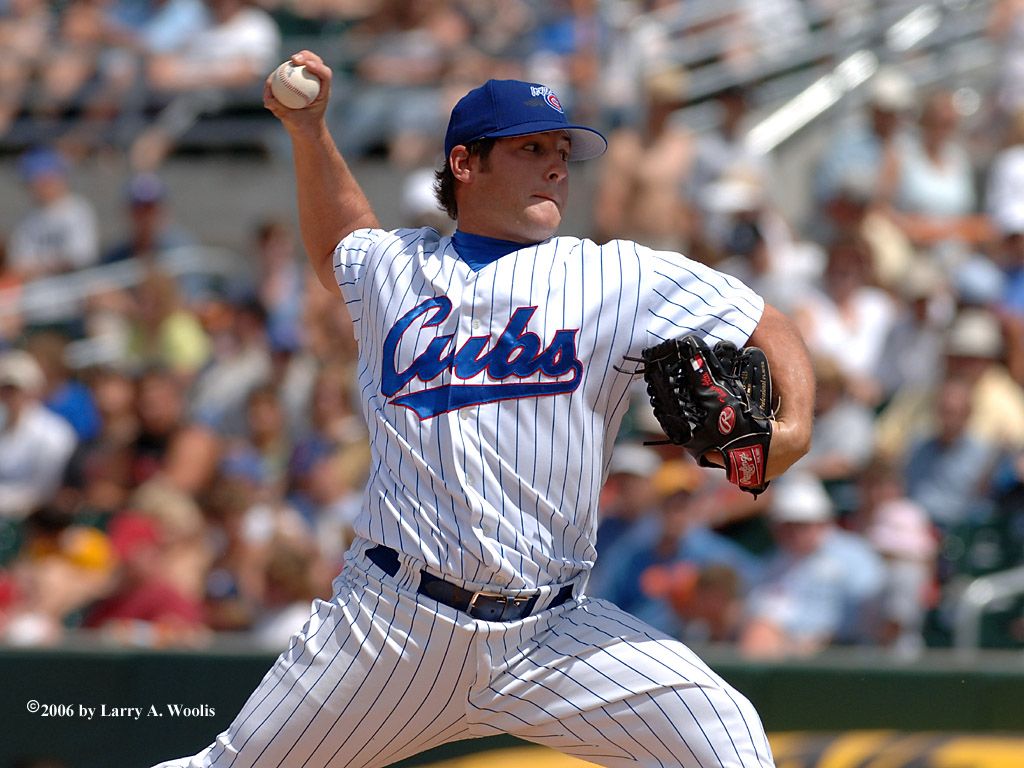
David Aardsma came to the Cubs in 2005 in the trade that saw LaTroy Hawkins sent to San Francisco. Aardsma was a reliever who wasnt totally terrible with a 4.08 ERA for a lousy Cubs team. That would be Aardsmas only season in a Cubs uniform as he would be dealt to the White Sox in the trade that netted the Cubs Neal Cotts. He would be mostly a middle reliever until 2009 when he saved 38 games for Seattle. After another 30 save season, he would have injury issues that have kept him out of the majors since. While Cotts didnt really pan out, losing Aardsma wasnt the worst thing Jim Hendry did. It remains to be seen if Aardsma will have the kind of career the Cubs wish was spent with them. As of February 2012, Aardsma was signed to a minor league contract by the New York Yankees. I wish him well in moving forward. UPDATE: Aardsma is currently in the middle of rehabbing from Tommy John surgery. Its not known when he might be ready to return to the major leagues. As of September 2012, he was placed on the New York Yankees roster. He appeared in 1 game, allowing a home run in one inning. It is possible he may return in 2013.
Ted Abernathy
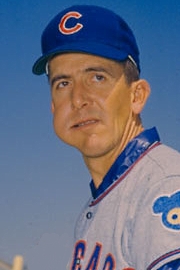
Ted Abernathy was a tall, submarining relief pitcher who was a set up man on the 69 Cubs though he was a closer for most of his career, as well as one of the first great workhorse relief pitchers who set records for games pitched. He was also involved in not one but two, of the worst trades of John Hollands career.
He first came up with Washington as a starter, but struggled. Then an arm injury forced Abernathy to change his throwing style to an underhanded motion that transformed his career. After 2 seasons with Cleveland where he saved 23 games and appeared in 96 games, he was sold to the Cubs where he really came into his own, leading the league in saves with 31 and setting a record by appearing in 84 games. After seeing his number slip in 1966, saving only 4 games(remember the 66 Cubs lost 103 games that year, so they were pretty bad!), Abernathy was dealt to Atlanta for Lee Thomas, who did absolutely nothing for the Cubs. After having some success with the Braves, he was drafted by the Reds where he had a huge year, saving 28 games, appearing in 70 and recording an ERA of 1.27! In 1968 he had another solid year, though he only saved 13 games. Then in Jan. 1969 the Cubs reacquired Abernathy and he was immediately installed as a set-up man for Phil Regan. He had a solid ERA around 3, but Regan faltered down the stretch. Years later, even Durocher admitted that he should have used Abernathy as his closer down the stretch. Given this, what happened afterwards is really peculiar. After 11 games where Ted continued to be solid with an ERA of 2.00, he was traded to the Cardinals for utility IF Phil Gagliano who proved to be useless. Why Holland made this dumb trade has always perplexed me. There must have been something else going on, but I dont know what it could have been. Abernathy never seemed like a troublemaker, unlike Dick Selma or Oscar Gamble or Adolpho Phillips, who had all been traded in the previous year for reasons not completely related to performance. To make a long story short, Abernathy wound up in Kansas City where he had 3 more productive seasons. He would be released following the 1972 season, even though he had a 1.70 ERA and still seemed to have something left in the tank. Perhaps he asked to be released. Its hard to say. Following one last season in the minors, he would retire to his native North Carolina where he would live until his death in 2004. I will always have memories of the lanky submariner and his important contribution to the history of the Cubs.
Cliff Aberson
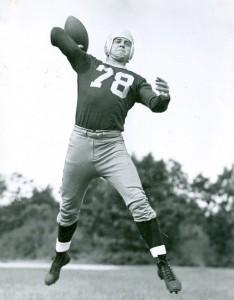
Before there was Bo Jackson or Deion Sanders, there was Cliff Aberson. To Cubs fans, he was an outfielder who appeared in 63 games between 1947 and 1949, but he was so much more than that. He served his country in World War II and then following the war he joined the Green Bay Packers to play football. In 1947 he was convinced to quit playing football and join the Cubs where he hit a respectable .279 in 47 games, but somehow was never really given a chance to follow up on that as he only appeared in 16 games the next 2 seasons. Although he would retire from baseball after 1950, Aberson could look back on an interesting career and the owner of a rare feat.
Johnny Abrego
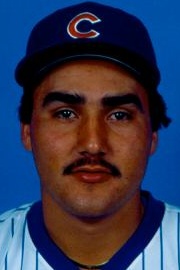
Johnny Abrego was a pitcher who was pressed into action in 1985 mostly because of the fact that the entire Cubs rotation went down at the same time.
Abrego was yet another former Phillie picked up by Dallas Green. Abrego had been drafted by the Phillies in 1981, but the Cubs picked him up in the 1983 Rule 5 Draft. He was considered a top prospect at the time, but if I remember right he was plagued by injuries most of his career. He made it to the Cubs despite having a lousy year at Triple-A, Im guessing it was because kids like Greg Maddux and Jamie Moyer were not quite ready to face major league hitters. Unfortunately, Abrego struggled to an ERA of 6.38 with 1 win and 1 loss. It was pretty much a lost season for everyone. Abrego never returned to the majors as injuries took their toll and he would be out of baseball by 1987. Today I believe that Abrego lives in Fremont, California with his wife and I think they have a daughter. I couldnt find much else on him. If anyone has any info on his current status, feel free to let me know.
Jimmy Adair
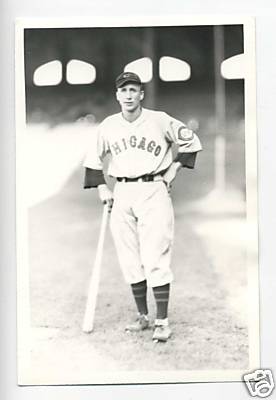
Jimmy Adair was a SS who appeared in 18 games with the Cubs in 1931. However, with Billy Jurges the everyday SS his future was limited. But he was one of those guys who spent most of his life in professional baseball, spending 17 years playing, then managing. He would become a coach with old high school teammate Paul Richards on the White Sox in 1951. After a stint as a minor league manager he returned to coaching in 1956 and spent the next 21 years as a coach, usually with Richards, though he also worked with the A's and the Kansas City Royals. In his later years he worked as a teacher at the Jimmy Adair Baseball Camp in Plano that was operated by his son. He passed away in 1982. After his death, his accomplishments in pro baseball would be recognized by his enshrinement in the Texas Baseball Hall of Fame.
Bobby/Mike Adams
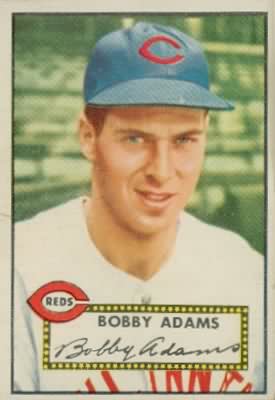
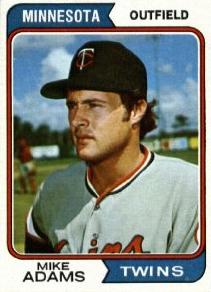
Bobby and Mike Adams represented that rare instance of 2 generations of ballplayers that played with the same team. In the annals of Cub history, there have been several, including Gary Matthews and Gary Matthews, Jr., Randy and Todd Hundley, Marty and Matt Keough, Chris and Justin Speier, Jim and Chad Tracy. Indeed, baseball was in this families blood as Bobbys brother Dick also played in the major leagues. He was originally signed by the Reds and was slated to join them in 1942 when the war kind of got in the way. Adams and his brother Dick ended up serving at the same base with Joe DiMaggio in Santa Ana. After a stint there that included a formidable baseball team, Bobby would be sent to the Pacific along with a contingent of 93 other ball players including Enos Slaughter, Joe Gordon, Birdie Tebbetts and Howie Pollet. They would play baseball across the islands for the troops stationed there. Following the war, Adams finally made it to the majors in 1946 where he spent 10 years with the Reds. Though he was a back up infielder for most of his career, he did spend a couple of productive years as a starting 3rd baseman in 1952 and 53. By the time he got to the Cubs in 1957 he was a utility player. By 1959 he reached the end of his playing career and in between stints as a minor league coach served as secretary for the Association of Professional Baseball Players as well as President of the minor league Tacoma Cubs. He seemed to be dedicated to professional baseball, even if it wasnt at the major league level. He was a member of the infamous "College of Coaches" from 1961-65 and returned to coach in 1973 as a member of Whitey Lockmans staff. After a few more seasons in professional baseball, he retired following the 1981 season.
Son Mike first came up to the majors with the Twins in 1972 as a backup outfielder. He was acquired by the Cubs in 1975 and appeared in 27 games, getting 4 hits in 40 ABs. He would be dealt to Oakland following the 1977 season. He would be out of baseball following 1978.
Bobby passed away in 1997. Mike Adams is now living quietly in retirement.
Karl Adams

Karl Tutwiler Adams was a pitcher with Chicago Cubs in 1915, compiling a 1-9 won-lost record in his brief career. Adams was a native of Columbus, Georgia. He was the original Rebel years before Randy Hundley. He originally played with the Reds but was acquired by the Cubs in 1915. He was a veteran of World War I and a member of the Veterans of Foreign Wars Old Guard Post 2100. Following his stint with the Cubs he played in the minors until 1925. After baseball, Karl worked for a number of years as a golf professional in Illinois and Kentucky. He was also a member of the Plumber and Pipefitters Union Local 265 and the Port Gardner Golf Club at Everett's Municipal Golf Course. He died in Everett, Washington, where he had lived for the previous 27 years.
Red Adams

Charles Dwight "Red" Adams appeared in 12 games with the Cubs in 1946 with an ERA over 8 and one loss. That would be the extent of his major league playing career. But he spent 15 years pitching in the minor leagues, then became a pitching coach, ending up as a coach in the Dodgers organization. In 1969 Adams joined the coaching staff of Dodgers HOF manager Walter Alston and under Adams tutelage, a string of Dodger pitchers had great success, including Don Sutton, Andy Messersmith, Tommy John, Mike Marshall, Bob Welch and future Cub Rick Sutcliffe. Adams remained pitching coach under Tommy Lasorda until 1980 when he retired. As far as I know, Adams is still enjoying retirement at age 90.
Earl "Sparky" Adams
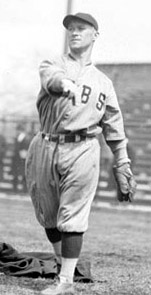
Sparky Adams was an infielder who played for the Cubs in the mid 20s, but ultimately would best be known for being traded for Kiki Cuyler. Coming from Pennsylvania, Adams signed with the Cubs and made his debut in 1922, hitting .250 in 11 games, playing 2nd base. After a year as a utility infielder, he became a regular, hitting .289, .280, .287, .309 and .292. He was a steady lead off man, leading the league in plate appearances in 1926. He also scored over 90 runs 3 years in a row. On Nov.28, 1927 Adams was dealt to Pittsburgh with OF Pete Scott in return for Cuyler, who would become of the best center fielders in the history of the Cubs. Adams had a solid season with the Pirates, but the next year would see a drop off in numbers and he would be dealt to St. Louis. In 1931 he would rebound with one of his best seasons, hitting .293, 97 runs scored and a league leading 46 doubles. Adams would even finish 9th in MVP voting in helping the Cardinals win the Series. Injury issues would take its toll on him over the last few seasons and he would retire following 1935.
After retirement he became a farmer and later a service station operator. He would pass away in 1989 at the age of 94. He would be the last remaining player from the 1931 St.Louis Cardinals championship team. My thanks to Diamonds and Dugouts for filling in some of the blanks of Adams career.
Terry Adams
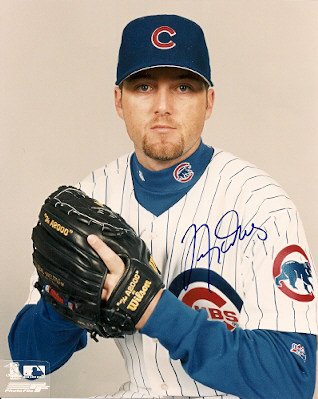
Terry Adams was a relief pitcher in the mid to late 90s, not quite having the success that he seemed destined for early on. He signed with the Cubs in 1991, making the team in 1995. In 18 games he would up with an ERA over 6. But in 1996 working in middle relief he posted a solid 2.94 ERA. With the Cubs bullpen in a state of flux, Adams would up as closer for a time, earning 18 saves, but a 4.62 ERA. In the wild card year of 1998, Adams returned to middle relief, though his ERA continued to hover around 4. Another stint as closer in 1999 brought 13 saves but an ERA of 4. He would be dealt to the Dodgers following the season. After leaving the Cubs he actually did some starting with some success(winning 12 games in 2001), but was mostly a middle reliever. Other than a 2.65 ERA in 2003, he was only moderately successful most of his career. He retired following the 2006 season with an ERA of 4.17, not terrible, but not especially great, pretty much a typical journeyman.
Bob Addis
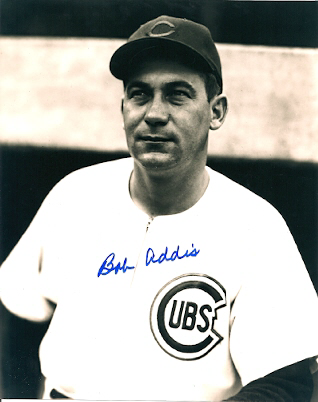
Bob Addis was a journeyman outfielder who spent a season and a half with the Cubs. Born in Ohio he attended Kent State then served in the Marines during World War II. Originally signed by the Yankees he returned to play in the minors following the war, getting traded to the Boston Braves and finally made his big league debut in 1950. Afterhitting .250 in 16 games in '50 and .276 in 1951, he was dealt to the Cubs for 1952. With the Cubs he appeared in 93 games and hit a solid .290 as a spare outfielder. Just as he seemed primed to take a big step forward, he hit a wall in 1953, appearing in only 10 games, hitting .167. Not sure why he didnt get more of an opportunity, the Cubs bench that year was full of .230 hitters. But he would be dealt to Pittsburgh on June 4 in the package that brought Ralph Kiner to the Cubs. Appearing in only 4 games he would be released 9 days later. He ended up spending 4 more years in the minors before call it a career in 1956. Returning to his home he would become a successful high school baseball coach and was eventually inducted in the Ohio High School Baseball Coaches Association Hall of Fame in 1975. Now aged 86, Im guessing that he still lives in Ohio.
Dewey Adkins
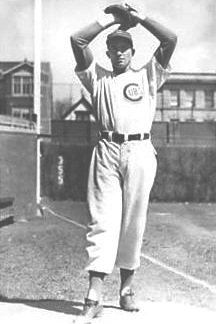
Dewey Adkins was a pitcher who appeared in 30 games for the Cubs in 1949. He had been originally signed by Washington and appeared in 8 games in 1942 and 1943 before serving in WWII. Following the war he would be drafted by the Cubs and joined them in 1949. Winning 2 games, but with an ERA of 5.68, he showed good speed, but seemed to have control problems averaging 4 walks per 9 innings and only 4 SOs per 9 innings. He must never have quite gotten over the control issues as he would not appear in another major league game, though he had a lengthy minor league career. He would remain in the minors until 1955. He spent his post playing career in California and passed away in 1998 at the age of 80.
Rick Aguilera
Rick Aguilera was just another in a long line of veteran closers brought in to try to replace Lee Smith, following in the footsteps of such names as Goose Gossage, Mitch Williams, Chuck McElroy, Randy Myers and Rod Beck. Like Gossage, Myers and Beck, Aguilera was already an established star as a closer, however, unlike Myers and Beck and more like Gossage, Aguilera was near the end of the line by the time he reached the Cubs.
Aguilera first came up to the Mets in the early 80s as another one of their hard throwing young stud pitchers, originally he was a starter. He won 10,10 and 11 games in his first 3 seasons in the majors, posting ERAs in the mid 3s each year. But in 1988 he struggled and in 1989 he was converted to a reliever, earning 7 saves. But he was traded to the Twins later that year, where he was used as a starter again, going 3-5. But in 1990 he returned to the bullpen where he became a dominant closer. He put together 4 30+ save seasons until 1994 when the strike held him to 23.He would be traded to the Red Sox in 1995, though he returned to Minnesota as a free agent the next season. In 1996 he returned to starting but struggled to an ERA over 5. Then he returned to closing in 1997, where his numbers began to decline. When he was dealt to the Cubs in 1999, he had a 1.27 ERA, though with the Cubs it was 3.69. Its worth noting that one of the players the Cubs gave up was Kyle Lohse, who, while not being a superstar, has had a productive major league career, making this trade not exactly one of Andy McPhails better moves. Aguileras 14 saves was his lowest total as a closer since he began closing. Still he was seen as insurance for Rod Beck who had undergone surgery. However, 2000 was not a good year for Rick, even though he had 29 saves, but his ERA was near 5. He began to be plagued by arm problems and it was clear his days in the major leagues were numbered.He was granted free agency following the season and his playing career ended.
Today, Aguilera, a devout Christian, is a high school baseball coach, real estate investor and popular speaker.
Its just too bad the Cubs couldnt have had him in his prime. 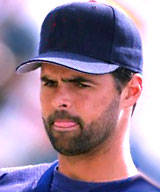
Hank Aguirre
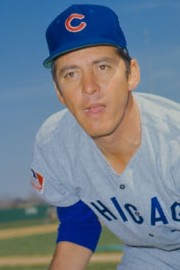
Hank Aguirre was a middle reliever on the 1969 Cubs who was very dependable, even though, like most of the bullpen, were forgotten by Leo Durocher by the end of the season. Perhaps though, his most famous contribution to the Cubs came following his playing career came when he was hired as liasion between Leo and the players following the clubhouse revolt in 1971. Before that, Aguirre had a fairly productive career in the major leagues.
Born in Azusa, California, this son of a grocer signed his first professional contract in 1951, finally making it to the big leagues in 1955 with Cleveland. After 3 years of not getting much of a chance, Hank was dealt to Detroit in 1958, where he became part of their bullpen. After 2 fairly productive years as a reliever, he would be given a chance to start and had a very impressive season, winning 16 games, leading the AL in ERA with a 2.21 average, making the All Star team and even finishing 17th in MVP voting. Aguirre joined a strong Detroit rotation which included Jim Bunning and future Cubs bullpen mate Phil Regan. The next year he won 14 games though finished under .500 for a Tiger team 6 games under. After a down year in '64, he bounced back with 14 in '65, but his days as a starter with Detroit were numbered with youngsters Mickey Lolich and Denny McLain joining the rotation. So in 1966, he returned to the bullpen then found himself traded to the Dodgers in April 1968, joining his old Tiger teammate Regan again, though Regan would be gone by June, being traded to the Cubs. In spite of a 0.69 ERA, Aguirre found himself released by the Dodgers, but would be picked up by the Cubs. At first it seemed like a good trade. Aguirre, as a left hander, was used in select situations as part of a solid veteran bullpen. But as the season wore on, Leo Durocher would use Aguirre less and less and depend more on Regan. It was this dependence that helped to doom the Cubs chances. Still, in 41 games, Hank was effective, with a 2.60 ERA. Following the disappointing season, Aguirre returned but he had clearly lost it, ending up with a 4.50 ERA and was released mid-season. Meanwhile, with the growing tensions between Durocher that culminated in a clubhouse revolt, Aguirre was brought in as a liason. However that experiment didnt last long as Durocher was fired in mid-1972 and Aguirre would quit baseball after the season.
Following his baseball career, Aguirre got into business, setting up shop in Detroit with Mexican Industries, a company that helped supply minorities to the car manufacturers. It became very successful, earning up to $35 million by 1989. Aguirre would continue to run that business until death in 1994.
Aguirre always regretted that the Cubs didnt win in 1969, I think probaly because he had never played in post season and this looked like his last chance. But I think he was glad for the chance to play on that great team. One only wonders what might have happened if Durocher could have done a better job utilizing his bullpen.
Jack Aker
Jack was a reliever who came to the Cubs in return for Johnny Callison and actually had a couple of productive seasons with the Cubs. He replaced a fading Phil Regan and gave the Cubs one of the brighter spots of a season that saw the end of the Durocher era.
Born of Potawatanami descent, Aker was raised in California and signed with the Kansas City As in 1959, he made it to the big leagues in 1964. Of course, being a closer with the forlorn As meant limited save opportunities, although Aker did lead the AL in saves in 1966 with 32. That would be his high water mark in the majors, normally averaging around 12. In 1969 he would be selected by the expansion Seattle Pilots, but fortunately only lasted 15 games before being traded to the Yankees in May. With the Yankees he would have the best seasons of his career, teaming up with ex-Cub Lindy McDaniel to form a strong twosome. In 4 years in NY, he would average an excellent 2.23 ERA with 31 saves. But in 1972 the Yankees would go in a different direction with Sparky Lyle ending up as their closer. For the Cubs it was a chance to move a declining Callison. Aker would be very effective, earning the second highest number of saves in his career with an excellent 2.96 ERA. Considering the team was never really in contention, Aker did pretty well. 1973 was something of a disappointment as his ERA rose to 4.10, but he still saved 12 games. From there he would be dealt to Atlanta, then the Mets where his career would end. After 10 years as a minor league and coach, plus 2 years as a major league coach with Cleveland, Aker founded Jack Aker Baseball, Inc, offering camps, clinics and private instruction to individuals, teams and leagues throughout the United States. Today, he teaches 3,000 students a year, from tee-ballers to 35-plus adults. In 1997, he was honored by President Clinton with a "Giant Steps Award" for coaching for his work teaching at-risk Native American children on reservations in Arizona and New Mexico. Aker was living in Arizona as of 2008. His son, Joshua Charnin-Aker, appeared on "Jeopardy!" Kids Week in 2002, competed in the 2008 United States Swimming Olympic Trials, and swims for Stanford University. Another son, Matthew Aker, is the head baseball coach at Greensboro College in North Carolina. Aker's youngest son, Adam Charnin-Aker, plays baseball for perennial powerhouse Chaparral High School in Scottsdale, AZ and his wife, Janet Charnin-Aker has appeared on "Who Wants to be a Millionaire?". A very interesting post-major league baseball career, indeed!
Dale Alderson
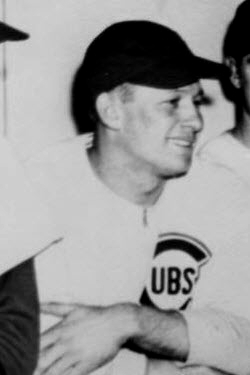
Dale Alderson was another wartime Cub who had little success at the major league level, but can be proud of his service to his country and what he did in his post baseball career.
Dale Alderson was born in the small town of Belden, Nebraska and distinguished himself as a 3 sport athlete at Upper Iowa University in Fayette. He signed with the Cubs out of high school and worked his way up to the majors by 1943, where he appeared in 4 games with an ERA over 6. He returned the next season, appearing in 12 games with virtually the same ERA. That ERA got him optioned back to the minors in July, then in September he took a pre-induction physical after he had been rejected twice for a kidney ailment then joined the Navy where he served for a year. Following his discharge he rejoined the Cubs, he was attacked and injured his hand. He did not appear in any games in 1946 and following the season he retired and became athletic director at Audubon High School until 1949 when he resigned to study for his Masters at Drake University. He continued to play semi-pro ball throughout the 50s. I would assume that Alderson continued to teach though I cant find any more information on that. He would pass away in 1982 in Garden Grove, California, though he would be buried in his hometown of Belden, where their website proudly proclaims that "they are the home of former Cubs pitcher, Dale Alderson"!
Vic Aldridge
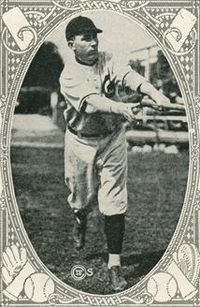
Vic Aldridge was a pitcher with the Cubs who pitched had several productive seasons before being dealt to the Pirates in the trade that brought the Cubs Charlie Grimm. He had a relatively short career, retiring when he couldnt get the raise he wanted. His post baseball career is also interesting.
Born in Terre Haute, Indiana, he was pitching for Indianapolis when he was discovered by the Cubs. He was signed by them in 1917, where he won 6 games with an ERA around 3. He only appeared in 3 games in 1918, before going off to war, joining the Navy. Following the war, he pitched for Los Angeles, a minor league affiliate of the Cubs. He would return to the major leagues in 1922, winning 16 games with an ERA of 3.52. Those would be pretty much the numbers he would post in 3 seasons with the Cubs, going 47 and 36 in that time. Then, October 27, 1924, Aldridge would be dealt to the Pirates with George Grantham and Al Neihaus in the deal that netted the Cubs Charlie Grimm and Rabbit Maranville. It was a great deal for the Cubs as Grimm would spend most of the next 60 years associated with the Cubs in one way or another. As for Aldridge, he was continued to be consistently productive for the Pirates, winning 15, 10 and 15 games for the Pirates. Aldridge also appeared in 2 World Series, 1925 and 1927, he won 2 games in '25, none in '27. More of the same was expected, but Aldridge felt he deserved a raise, but instead of giving him one, the Pirates traded him to the Giants where he refused to play most of the year and when he returned he struggled and ended up being traded to the Reds, but instead of reporting he retired. Of course, while the usual thing is to side with the player, but interestingly enough, if you look at his numbers they actually seem to be declining, so you can almost understand the Pirates' and Giants' reluctance to give him a raise. But Aldridge was a man of integrity and he retired, went to law school and served in the Indiana State Senate from 1937 to 1948. He passed away in 1973 and in 2007 was elected to the Indiana Baseball Hall of Fame.
Grover Cleveland Alexander ***Hall of Famer***
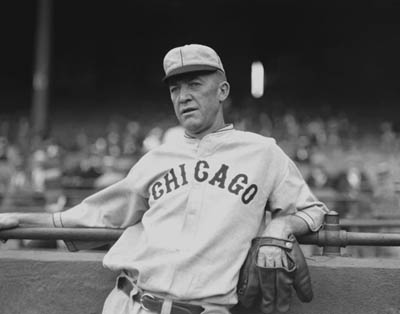
Grover Cleveland Alexander was not only one of the greatest pitchers in the history of the Cubs, he was one of the greatest pitchers in the history of baseball, his 373 victory total ties him for 3rd place all time with Christy Mathewson. Whats remarkable is that he could easily be lumped with great players past their prime by the time he came to the Cubs, yet, although his 30 win seasons were behind him by the time he came to the Cubs, he still managed an impressive 128 wins in his 9 years with the Cubs and but for his feud with Joe McCarthy that got him traded to the Cardinals, he might have had even more. By the time he reached the Cubs, he was already in the throes of an alcoholism that would eventually take its toll on his playing ability and almost certainly shortened his life.
"Pete" Alexander, as he was known to baseball insiders, was born in the small town of Elba, Nebraska and found himself drafted by the Phillies in the Rule 5 draft in 1910. Almost from the start he was a big time hurler, winning 28 games his first season. He would lead the league in wins, shutouts, innings pitched and complete games, looking very much like a veteran. Over the next 7 years he would win 30 games 3 times, get his ERA under 2 3 times(including an astounding 1.22 in 1915!) In 1916 he pitched 16 shutouts! The numbers he put up in Philadelphia are just mind boggling. In the 1915 World Series, he was very solid, but only won one game as the Phillies lost to Babe Ruth and the Boston Red Sox. The 8 years he spent with the Phils were truly impressive:190 wins, 61 Shutouts, 2.18 ERA, 219 Complete Games! So why the Phillies chose to part company with Alexander is just as much a mystery as anything. On December 11, 1917, Alexander was traded to the Cubs with catcher Bill Killefer for Pickles Dillhoefer, Mike Prendergast and $55,000.
He only had a chance to appear in 3 games in 1918 when he was called up to join the US Army and WWI. However, it was during his time in France that misfortune struck that would affect him for the rest of his life. A shell exploded close to him and cost him hearing in one ear. It was while he was in the hospital that he was also diagnosed with epilepsy. He would return to pitch for the Cubs in 1919 and won 16 games with a league leading 9 shutouts, while also leading the league in ERA with 1.72. In 1920 he won 27 games with a 1.91 ERA. While his ERAs and shutouts declined in coming seasons, he still posted solid win totals, 15, 16, 22. However, due to war trauma and bouts of epilepsy, he began to drink more and more and it didnt take long for it to affect his performance. in 1925, following a 15 win season he would be admitted to a sanitarium. He returned in 1926, but had problems with new Cubs manager Joe McCarthy. On June 26, 1926, following a period of 10 days in which he showed up drunk 6 times, he was waived and picked up by the Cardinals. Many people believe that when Killefer left, it affected him because Bill had helped keep him in check. Now Killefer was with the Cards and reunited, he found a new motivation. Alexander will be forever remembered for his appearance in the 1926 World Series in which he struck out Tony Lazzeri with the bases loaded, then caught Babe Ruth trying to steal. Pete came back to win 21 games in 1927, then 16 the next, but the alcoholism would take its toll and Alexanders numbers declined and after one last stint with the Phillies was released in 1930. Sadly he would die broke in a boarding house in 1950. He would be inducted in the HOF in 1938 but that was not enough to keep his life from taking a sad turn.
He would also be made famous for being the only player named after one President and potrayed in a movie by a future President. That movie was "The Winning Team" starring then actor Ronald Reagan. Of course, at the time no actor had ever become President, so it is a rare thing indeed.
In the end he will be remembered for his contributions to the history of the Cubs as well as to baseball in general.
Manny Alexander
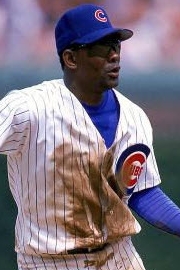
Manny Alexander was utility player who spent parts of 3 seasons with the Cubs. He had good speed with no real power and wasnt an especially great defensive player, but he had his value being able to play several different positions. He was originally signed by the Orioles and spent 4 seasons there before being traded to the Mets. After a half a season in New York he was sent to the Cubs as part of the deal that brought Lance Johnson to the Cubs. Alexander hit .293 in 33 games and got a chance to play semi regularly in 1998, however he only hit .227, yet he was brought back in 1999 where he hit .271. So naturally he would be rewarded with a trade to the Red Sox for Damon Buford. He played another 4 years with Boston, Texas and San Diego. He seems to be an example of how bad the Cubs were in 1997, because if a utility player like Alexander got in that many games, what does that say about the quality of the team as a whole? Things seemed to even out the next year when Manny was hardly a factor in the Cubs winning the wild card. Such is the career of a journeyman Cub!
Matt Alexander
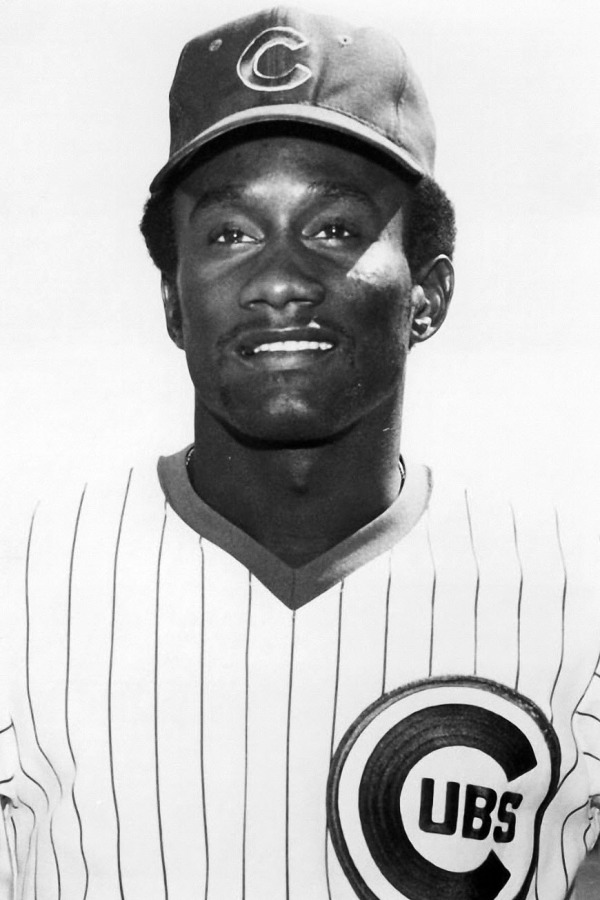
Matt Alexander was a utility infielder who played with the Cubs in 1973 and 1974. Raised in Shreveport, Louisiana and attended college at the legendary Grambling University, Alexander was signed to the Cubs by the great Buck O' Neill. He made it to the major leagues late in the 1973 season, in the middle of the decline of the great veteran '69ers, coming into a game as a pinch runner for Ron Santo. In 12 games he hit .200 and stole 2 bases. Stealing bases would become a part of what Alexander was in the big leagues. In 1974 he hit .200 in 45 games with 8 steals. Traded to Oakland before the 1975 season he would find his niche as a professional pinch runner. He would replace Herb Washington as the main designated pinch runner in Oakland. He would play a couple of years in Oakland then ended up with Pittsburgh where he became a member of the 1979 "family" team. He won a Series ring, though he was not a huge factor in the Pirates victory. After a couple of more seasons in Pittsburgh, he found himself in Mexico where he was able to play until the mid-80s when he finally retired as an active player. After several attempts at coaching jobs, he would go into business for himself, where he works today.
Antonio Alfonseca
Antonio Alfonseca was yet another attempt by the Cubs to bring in an established closer that didnt quite work out. Within 2 seasons, Alfonseca would be gone from the Cubs and not much longer before his career pretty much petered out.
Much of AAs noteriety comes from the fact that he was born with 6 fingers on his right hand, though unlike 3 finger Brown, this freakish addition did not impact his ability, one way or another. He first came up with Florida in 1997 and by 1999 had established himself as a good closer, with 25 saves to his credit that year. In 2000, he led the league with 45 saves, though his ERA of 4 was awfully high for a reliever. In 2001 he had 25 saves with an ERA a run lower. However, one of Alfonsecas problems was his tendency to put too many man on base. His WHIP was usually higher than you would like from your closer. In 2002 the Cubs acquired AA along with Matt Clement in return for Julian Taverez, Jose Cueto, Ryan Jorgensen and a kid named Dontelle Willis. At the time it didnt seem like a big deal, especially when Clement turned out to be a great addition, but Alfonseca was a disappointment from the start, with an ERA of 4 and only 19 saves. In 2003 he had injury issues, lost the closers job to Joe Borowski and wasnt even a factor in the Cubs winning the division. Following the season AA signed with Atlanta where he actually had a decent year as a middle reliever, but after that his numbers continued to disappoint and he would bounce around, back to Florida, then Texas and finally Philly where he finished his big league career in 2007. He would go to Mexico in 2009 and then Independent teams through 2011, though as of this writing it appears his playing career has come to an end.
Yet another brief flash in the pan who had already peaked before joining the Cubs.
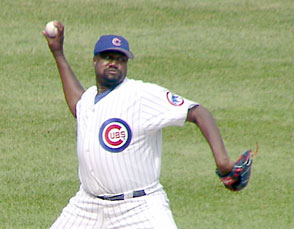
Ethan Allen
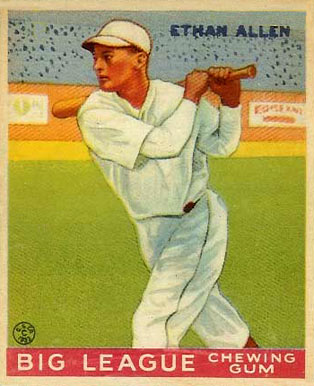
For most people the name Ethan Allen represents a hero of the Revolutionary War, a member of the legendary Green Mountain Boys, to others a furniture supplier, but for baseball fans, the name represents a one time star, career .300 hitter, to Cubs fans, he was a guy who spent a season on the North Side near the end of his career who is somewhat forgotten today. But he was actually a lot more, especially in the years after he retired, creating a popular baseball board game as well as coaching a future President at Yale.
Ethan Allen was born in Cincinnati and signed with the hometown Reds, joining them in 1926. In 56 seasons with the Reds, he hit .295 and was a decent player though nothing extraordinary. From there he went to the Giants where he was mostly a utility player then St. Louis. Suddenly, in 1934 he took his game to the next level, hitting a career high .330, 192 hits, 87 runs scored, 85 RBIs. He followed that up with an equally solid 1935, hitting 198 hits, scoring 90 runs. He got off to a somewhat slow start in 1936 when he was dealt to the Cubs with Curt Davis for Chuck Klein. It was actually a good deal, since Klein was never really suited for Wrigley Field and Davis was good young pitcher. Allen had decent numbers with the Cubs and might have put together a good year over the course of a full season, but they were apparently concerned that his production was dropping and he was getting older, so he was sold to the Browns where he had one decent year than retired following the 1938 season. In 1941, the game that he had created with the Cadaco company, All Star Baseball, was introduced. It was an immediate success. Then, in 1946 he became the baseball coach at Yale, where in 1948 he coached a player named George H. Bush, who would later become President of the United States. Allen wasw also at one time the National Leagues director of Motion Pictures(something I never realized they even had!) as well as writing several instructional books on baseball. As the All Star Baseball Game developed a cult status, Allen expressed shock that grown men were still playing it, as he had designed it for 9 to 12 year olds. “Holy mother, I’m glad there are only a few of you kooks. You’re trying to make an adult game out of a kids game." He retired from Yale in 1968, but continued to be involved with Cadaco until he passed away in 1993. Id like to thank Jack Major and http://major-smolinski.com/SLY/ETHANALLEN.html for some of the information here.
Nick Allen
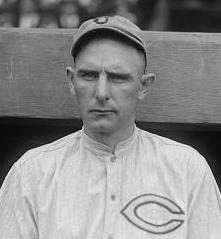
Nick Allen was a catcher who played only 5 games with the Cubs in 1916, but he sounded like he was kind of an interesting guy who spent more than 20 years in professional baseball as a player, scout and manager. He was even a member of the Reds team that defeated the infamous 1919 Chicago White Sox.
Nick Allen was born in Kansas, though his family was from the Chicago area. Allen began his pro career in 1910 with Wichita. From there he bounced around until 1914 when he signed with the upstart Federal League in Buffalo. He played sparingly thanks to injury and appendicitis. In 1915 he appeared in 84 games, the most of his major league career. Then in 1916, following the collapse of the Federal League, Allen was signed by the Cubs, though he only appeared in 5 games with 1 hit in 16 at-bats. He would certainly make an excellent candidate for the Al Montreuil Hall of Obscurity! In 1917 he was purchased by the Reds, then joined them in 1918 only to enlist in the Army. He was released from the Army in time to rejoin the Reds for the 1919 season where he only played in 25 games, but batted .320. His lack of playing time was probaly eased by the fact that his team won the World Series, albeit to a team that would be proven to have thrown the Series, but it was a championship, nevertheless. He would be dealt away by the Reds in 1921 where he would embark on a fairly successful managerial career. With St. Paul alone, he compiled a record of 447-384. He would continue to manage until 1934 and 35 when he did some scouting for the Yankees. He also helped run a family business for a couple of years in between. His last managerial job would be in 1936. In 1939, he would be hospitalized with cancer where he would pass away on October 17, 1939 in Hines, Illinois. Nick Allen was quite a feisty character, so its not surprising that he hung on for 7 months. He was well known as an umpire baiter and it was common knowledge that he did it because it attracted fans. The biggest disappointment of his life was probaly that he never got the call to manage or coach in the big leagues, something Im sure he would have been good at. He helped coach or tutor Leo Durocher, Mark Keonig and Chuck Dressen.
Thanks again to SABR for filling in the blanks on this interesting guys life!
Milo Allison
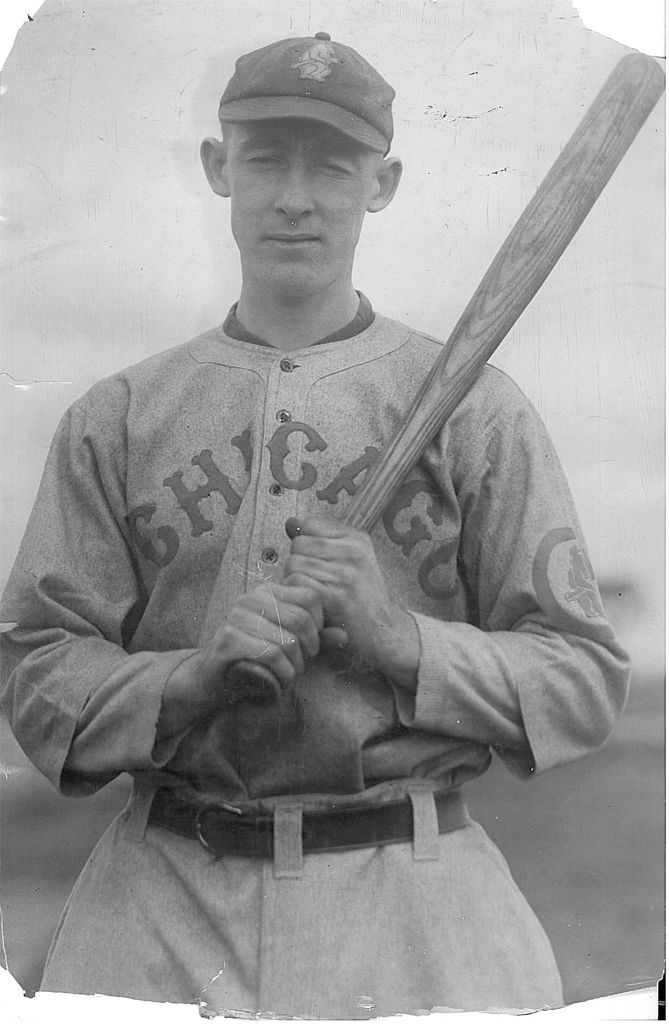
Milo Allison was an outfielder who appeared in 3 games for the Cubs in 1913-14. He was born in Elk Rapids, Michigan, came to the Cubs almost immediately, though he only managed 3 hits in 7 at bats for his career. After a couple of more years in the minors he returned to the majors with Cleveland, where he played in 46 more games over 2 seasons, then returned to the minors for a final season and thats where his career ended. Sadly, that is the only information I could find on this guy. I can only assume he settled in Kenosha, Wisconsin and lived a nice quiet life there, because thats where he died in 1917. I suppose I could dig a little deeper to research players like this, but is it worth it? If anybody knows anything about this guy, Id love to hear from you, because I would like to be able to update these profiles.
Moises Alou
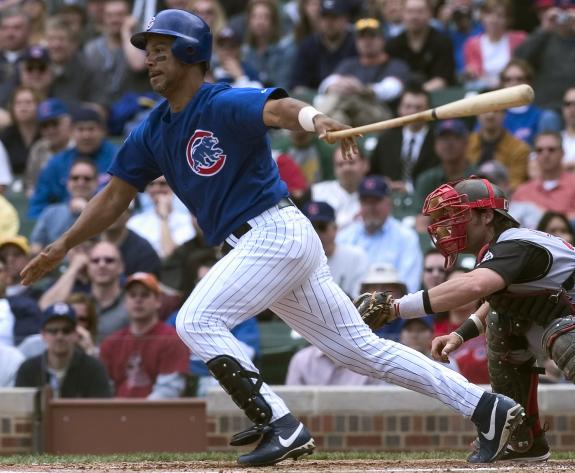
Coming from one of baseballs most famous families, Moises Alou can look back at an outstanding career with over 300 homers, a .303 BA, several All Star teams, a World Series ring and several other post season appearances, but his career with the Cubs will be forever defined by one moment of frustration over the act of an impetuous fan, for good or for bad. For me personally, I will always remember several walk off home runs he hit, the great hitting skill he brought to the Cubs more than a moment that most outsiders cant seem to let go of.
Moises Rojas Alou was born in Atlanta in 1966 while his father, Felipe Alou, was playing with the Atlanta Braves, in the midst of a very productive career. Felipe was the oldest of 3 brothers that all had lengthy major league careers. The Alous had come from the Dominican Republic, where the San Francisco Giants were in the midst of heavy recruiting in that area. It so happened that all 3 Alous(Felipe, Matty and Jesus) signed with the Giants and the fact that all were outfielders meant at some point the Giants had an all-Alou outfield. But by 1966, Felipe had been traded to Atlanta, Matty to Pittsburgh and Jesus to Houston. Moises went to high school in the D.R. where he would be signed by the team that once had Matty, the Pirates. After only 2 games in Pittsburgh, Moises would be dealt to Montreal in the trade that saw Zane Smith go to the Pirates. Alou was a perfect fit for an up and coming young Expo team. He would have a couple of solid years, but really came into his own in 1994, hitting .339 with 22 homers when the season came to any end because of the strike. Most people believe the Expos could have gone all the way, but thanks to the foolishness of the owners and players, they lost that and Alou lost an opportunity to really show the world what he could do. When the league resumed play in 1995, he had another outstanding year and a half, but in 1997 he signed with Florida Marlins as a free agent. With the Marlins he got the World Series he missed in Montreal, driving in a career high 115 runs and hitting .292. That winter, under a surprising rebuilding plan by Florida, he was dealt to Houston. He responded with 3 of the best years of his career, averaging .331 with 100 RBIs each year and an average of 30 homers. Those years in Houston represented the apex of his career. But on December 19, 2001, Alou signed with the Cubs. He was supposed to complement Sammy Sosa, but he had some injury issues that kept his numbers down. In the meantime the Cubs had changed GMs, bringing in Jim Hendry and began to remold the team to try to get it to post season. And Alou, feeling healthy again, made a comeback and turned out to a valuable player in winning the Central Division, hitting 22 homers with 91 RBIs. In the playoffs, against Atlant, Alou was big, hitting .500 with 3 RBIs and in the NLCS against former team Florida, he was very solid, hitting .310 with 2 homers and 5 RBIS. But it was in the fateful game 6 that Alou will always be remembered for. I dont think we need to go over the whole game, just the basic facts. Mark Prior was cruising with a shut out in the 8th inning, when everything unraveled. There was one out when Juan Pierre hit a line drive towards Alou in left field. The question will always remain.....could Alou have caught the ball if there was no interference? At the time, I believed that Alou could have caught it. Looking back, I have to think there was no guarantee that he could definitely have caught it. Even Alou himself, in the years since, has admitted that it wasnt a given that it was catchable. So what we are left with is a fan named Steve Bartman, who was clearly caught up in the moment, but if you look at the tape of the incident, he is not the only fan with his arm outstretched. And, lets face it, blaming Bartman, or even Alou, for that matter is ridiculous. Prior was the one who lost it at the worst possible time and the error by Alex Gonzalez, did no good, nor did the bullpen who allowed things to get totally out of control. I would be prone to absolve both Bartman and Alou of any real blame. In any case, this is the last time I will address the issue on this website.
In the aftermath of that disaster, Alou would return for another great season, hitting 39 homers and driving in 106 in what would be Alous last really great year. Following 2004, Alou would go to San Francisco to play for the team that originally signed his father and the team his father currently managed. But his knee problems caught up to him and though he hit .300 both years with the Giants, it was clear his days as an everyday player were over. He spent 2 final years in New York with the Mets where he hit .342 before finally calling it quits. What I notice about Alou is his ability to fashion his game around the ballpark where he played. In Montreal he could spray the ball around and still had the speed to take advantage of, but in Houston, he really used the ballpark to his advantage, finding his power, which is what he did with Wrigley, being able to take advantage of its short fences in summer when the wind was blowing out. It will be interesting to see what kind of support Moises gets for the Hall of Fame. Personally, I think he is short a couple of really dominant years, he seems more like a Harold Baines type, but who knows. I do know he was a great Cub and one moment in one game will not change that!
Porfi Altamirano
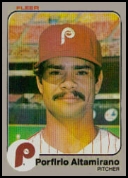
Porfirio Altamirano Ramirez was a Nicaraguan pitcher who was acquired by the Cubs in the same trade that brought them Gary Matthews and Bob Dernier, the trade that essentially got the Cubs into contention that year. As it turned out, Altamirano was pretty much just a throw in, yet another former Phillie acquired by one Philly farm director and then Cubs GM, Dallas Green. He was acquired by the Phillies in 1980 and pitched for them for 2 seasons, not pitching terribly out of the bullpen with an ERA just under 4. Then he came to the Cubs in 1984 during that division winning year, but his 4.76 ERA in 5 games wasnt much of a contribution to that effort. Almost as quickly as he reached the Cubs, he was gone, dealt to the Yankees in a trade that netted the Cubs Ray Fontenot and Brian Dayett. Suffice it to say it was not an epic trade. Altamirano would be out of American baseball soon afterwards, though he would pitch for a team in Venezuela in the late 80s. I havent found much info on what happened to him since, but Im guessing he returned to his home country at some point.
Joey Amalfitano
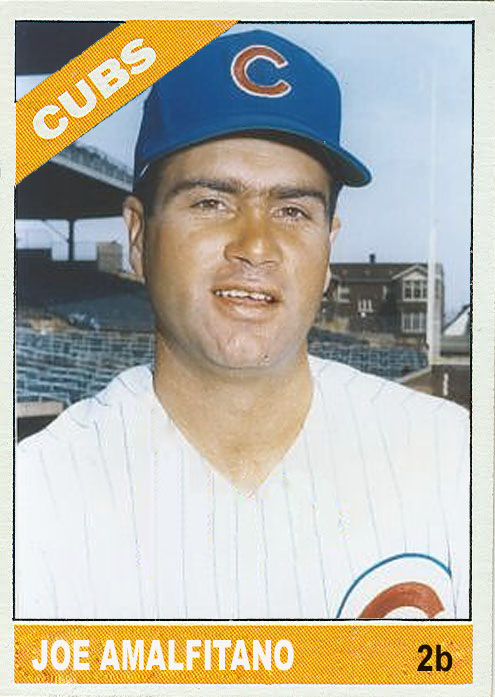
Joey Amalfitano is probaly best known for being a Cub coach, at least for me he always seemed to be a coach. I think Leo Durocher considered him a protege, though from what Ive read, Amalfitano is almost completely the opposite of Leo, personality wise. From what I know, he was a a quiet, church going man who didnt believe in swearing. In any case, his ties to the Cubs actually began as a player and is very much tied to the tragedy of the death of Kenny Hubbs. John Joseph Amalfitano was originally signed by the New York Giants as a bonus baby, which meant he had to stay on the roster for 2 years, which he did, watching while his teammates won a World Series. Having to sit on the bench did him no good, as it did in most bonus baby cases, so when he was sent down in 1956, it would be 1960 and the Giants would be relocated in San Francisco by the time he returned to the majors. He spent 2 seasons hitting for a decent average, but mostly becoming a utility infielder. Then he was picked up by expansionist Houston Colt .45s where he played fairly regularly, but only hit .237. He ended up back in San Fran the next season where he played even less and only hit .175. Meanwhile in Chicago, in February 1964, promising 2nd Base star Kenny Hubbs was killed in a tragic plane crash, which left the Cubs without a 2nd Baseman. They had to scramble to figure out how to replace him and part of that included acquiring Amalfitano on March 29. So Joey would be part of a committee that played 2nd Base that season, that included Roberto Pena and Jim Stewart. Joe played 100 games that season, hitting .241 and would return the next season, but with young converted SS Glenn Beckert now at 2nd Amalfitano was a utility man for the rest of his playing career. He would play for the Cubs through 1967, with Durocher now the manager and on July 6, 1967 he was released as a player, but remained as a coach. He became a favorite of Leos, though Im not sure that he shared those sentiments as he would leave the Cubs following the 1971 season, which iuncluded the clubhouse revolt. Its possible that he was tired of the turmoil. So he returned to the Giants for the next 6 years. Then in 1978 he would return to the Cubs, who were now managed by former Giants teammate Herman Franks and the GM was Bob Kennedy who had Amalfitano as a player. He coached there until the end of 1979 when Franks left in bitterness, attacking certain "chain" wearing players, that included Mike Vail and Ted Sizemore. Actually, Im thinking of doing an essay on the biggest crybabies in the history of the Cubs, Sizemore and Kent Mercker would probaly be at the top of the list! Joe was named interim manager, going 2-5. Preston Gomez would be named new manager, but when the team floundered under Gomez, Amalfitano was named to replace him and although they went 26-46 under Joe, he was brought back in 1981. The problem was, they had an absolutely horrid team during Joeys tenure and when the league went on strike, the Cubs were in last place at 15-37. Then shortly after the strike stopped play, Bill Wrigley III sold the team to the Tribune and pretty much made Amalfitano a lame duck. Franks had returned as GM, which probaly explains why he finished the season, but his days were numbered. When the season resumed, it was split in half and the team actually played better, but it was still pretty bad. I dont really blame Joey, I actually always liked him, he seemed like a decent guy and very low key, but I think that was part of the problem. This needed someone willing to kick butts and Joey just didnt do that. But he landed on his feet, spending a year with the Reds before moving on to be Tommy Lasordas 3rd Base coach with the Dodgers for 15 years. After some time as a minor league instructor with LA, Joey returned once again to the team that originally signed him in San Fran, where he currently works as a minor instructor and consultant.
Vicente Amor
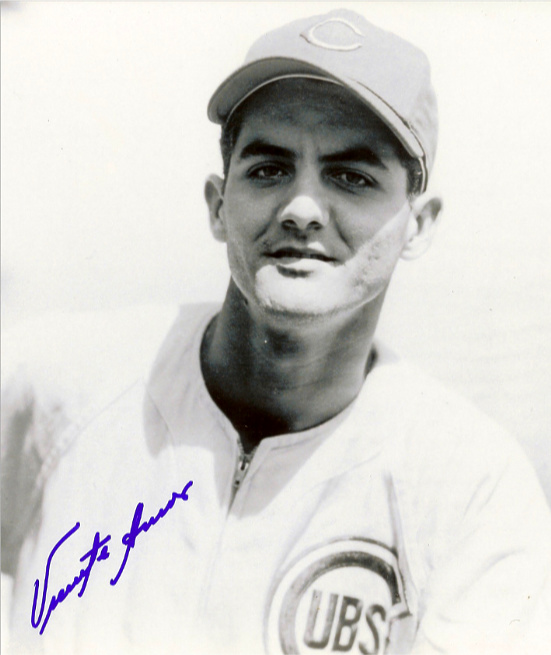
Vicente Amor was a Cuban pitcher who came to the US to pitch as a 17 yo. He was drafted by the Cubs in 1954 and appeared in 4 game for them in 1955, going 0-1 with a 4.50 ERA. He returned to the minors before resurfacing with the Reds in 1957, going 1-2 with an ERA near 6. That marked the end of his major league career, though he would pitch in Cuba for 2 more years, then I assume because of Castro he ended up in Florida, where today he owns a business that produces electrical signs. He was also inducted in the Cuban baseball Hall of Fame in 1998.
Bob Anderson
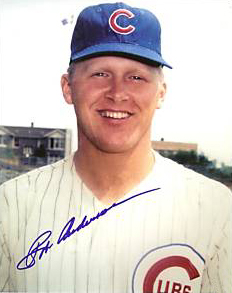
Bob Anderson was another of the young pitchers who came up to the cubs in the late 50s and like most of the others never really fulfilled his potential.
Born in East Chicago, Indiana, Anderson signed with the cubs in 1954 and arrived in Wrigley in 1957, having a 7.71 ERA in 8 games. The next season he had an ERA just under 4 in 17 and the next season joined the starting rotation, winning 12 games with an ERA around 4, even throwing a shut out. In 1960 he would win 9 games for a bad team with a similar ERA. That represented the high point of his career as his numbers would decline over the next 2 seasons. Following a 2-7 season he would be dealt to Detroit for Steve Boros in a trade that didnt do much for either team. After a final season in pro ball, he would call it a career. He would settle in Florida, where he still enjoys watching his old team.
Jimmy Anderson
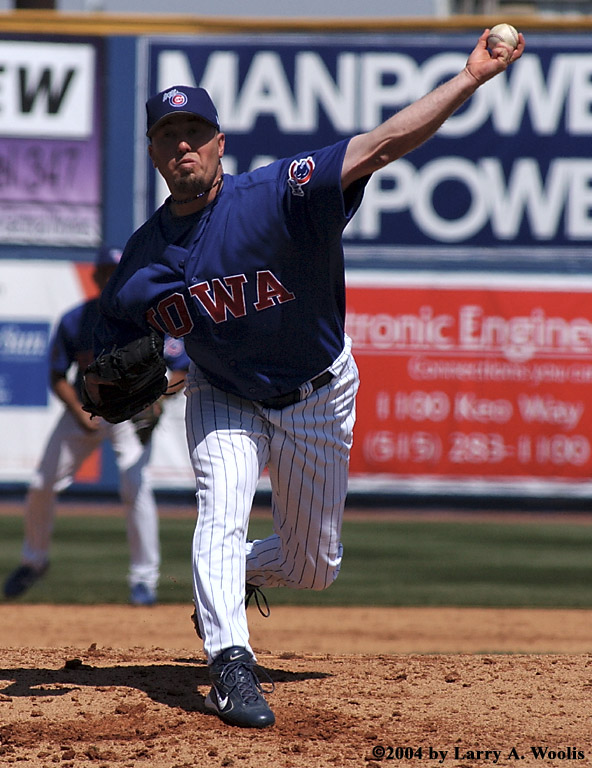
Jimmy Anderson was a journeyman pitcher who appeared in 7 games with the Cubs in 2004. Born in Virgina, Anderson signed with the Pirates, debuting with them in 1999, appearing in 13 games with an ERA around 4. In his first 3 seasons starting with the Pirates, he had a 25-41 record and an ERA of 5.00. After a season in Cincy, he signed with the Cubs. However, his stay in Chicago would be brief as he was traded to Boston in July. After an unproductive stint in Boston, Anderson actually resigned with the Cubs, but he was released before appearing in any more games. After bouncing around pro ball for 2 more years he would retire following 2006.
John Andre
_3.jpg?timestamp=1338132712597)
John Andre was a pitcher who appeared in 22 games with the Cubs in 1955, but he might be most famous for being a classmate of the legendary heavyweight boxing champion, Rocky Marciano.
Andre was born in Brockton, Mass. where he attended school with Marciano and played baseball with the future icon in the Brockton CYO. Marciano was a catcher and Andre thought Rocky was a pretty good player, ".......He would rather play baseball than fight, I’ll tell you that. He was big, rough and tough, just the way he is now, and he could hit and throw.”
Andre was 17 when he enlisted in the Signal corps in 1941 and was stationed in Hawaii, working on a communications system when the Japanese attacked on Dec. 7. He suffered a head wound, for which he was awarded a Purple Heart. He remained in Hawaii for much of the war and played for a team that played teams including the one Joe Dimaggio played on. He later transferred to the Air Force where he was a radio operator on a plane that was attacked by the Japanese and had to be rescued from a life raft. following the war, Andre and Marciano went to a Cubs tryout camp, though neither made it. Imagine how sports history would have been changed if Rocky Marciano had been signed by the Cubs. And how it might have changed the Cubs history too, considering how long it took them to find an adequate replacement for the legacy of Gabby Hartnett. In any case, Marciano hurt his arm, quit playing baseball and concentrated on boxing, while Andre eventually signed with the New York Giants. He slowly made his way up the baseball ladder, having some success but with a deep ballclub, the Giants had no room for him. After 8 years his contract was purchased by the Cubs and he finally made his major league debut in 1955, where mostly relieving he had a 5.80 ERA with what was another pretty bad Cubs team and was soon back in the minors. Finally, following one more season, Andre called it a career. He returned to Mass, working at Dunfey's Restaurant in Hyannis. He would pass away in 1976 at the age of 53. Another interesting career. Thanks to Baseball in Wartime for filling in some of the blanks on his service in WW2.
Shane Andrews
.jpg?timestamp=1339291603108)
Shane Andrews was yet another of many attempts to find a 3rd Baseman who could fill the shoes of Ron Santo. For whats its worth, Andrews had one of the better seasons of his career with the Cubs, though if you look at his career, thats not saying much.
Andrews was born in Dallas and signed out of high school by Montreal. After working his way up the farm system, he debuted with the Expos in 1995. He had excellent power, hitting 19 homers in 1996 and 25 the next. The problem was he struck out way too much and only hit .219 in 5 years with the Expos, very Dave Kingman like. After hitting only .181 in 1999, he was signed by the Cubs. In 19 games he hit 5 homers and .254, which you could say was a career high, if the season only lasted 19 games. The next year he hit 14 homers and a more typical .229 though he only struck out 59 times, albeit it was only 66 games, but you take what you can get! Following the season he was released and signed by the Cardinals though never made it with them. After a final stint with Boston in 2002, his major league career ended and he moved to Carlsbad, New Mexico where he lives today. He did wind up in the news one last time in 2009 when he was arrested for his role in a brawl involving his brother and 2 other men. No word on the outcome of the case. I assume it was settled and hes moved on because I have no other information. So it goes with another member of the Ron Santo successors club.
Tom Angley
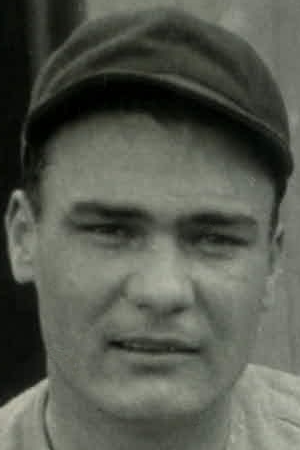
Tom Angley was a catcher who appeared in 5 games with the Cubs in 1929 and pretty much disappeared after that. Angley was born in Baltimore, Maryland, attended Georgia Tech and signed to play pro ball in 1927. After a couple of seasons he was signed by the Cubs and joined them in 1929 when Gabby Hartnett was out with a sore arm. On April 23, both starting catcher Mike Gonzalez and back up Earl Grace were injured, forcing Angley into the game. Angley would catch the next 5 games, actually hitting pretty well, with 4 hits in 16 ABs for a .250, not to mention 6 RBIs. He even stole 2 bases. However, Gonzalez and Grace must have both returned because Angley would never appear in another major league game. With Hartnett appearently sidelined all year, they eventually added veteran Zack Taylor who would get most of the starts for the remainder of the season and that left Angley the odd man out. Hartnett eventually regained his health and would return as the starting catcher, so its easy to see why Angley never really got another shot. Its suprising that no one else ever took a chance on him because he seemed to have some potential. In any case, Angley remained in pro ball until 1935. Following his retirement from pro ball, he moved to Kansas. Though I have limited information on his life after baseball, I think its safe to assume he remained active as a coach or instructor in his hometown at Wichita, because he was inducted into the Kansas Baseball Hall of Fame in 1990. He passed away in 1952 following a battle with myocarditis.
Jose Arcia
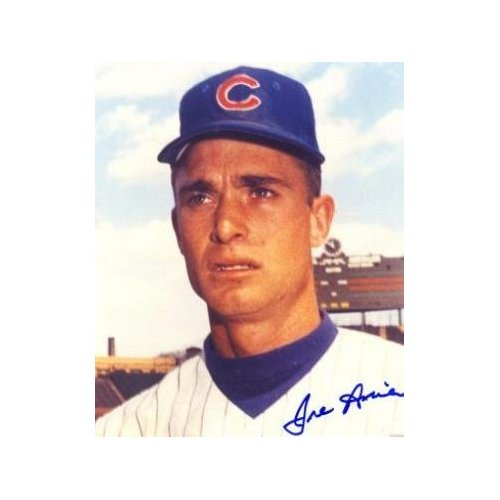
Jose Arcia was a utility player who appeared in 59 games with the Cubs in 1968. My own memories are of a light hitting player who seemed to personify a pretty lousy expansionist San Diego Padre team.
Jose Raimundo(Orta) Arcia was born in Havana, Cuba. Im not sure how he came about to be in the US in 1962 when he signed with the expansion Houston Colt .45s, because you know about Castro, but he spent 6 years in the minors before being drafted by the Cubs in the 1967 Rule 5 Draft. He would play the OF, 2nd, 3rd and SS, but only hit .190. Not surprisingly he would be left unprotected for the expansion draft which would stock the Padres, Montreal Expos, Seattle Pilots and Kansas City Royals. With the Padres he would spend 2 years, hitting only .218, though he did steal 14 bases in 1969. Following the 1970 season he would spend another 6 years in the minors before calling it quits. He managed for a season in 1982 and has been a scout for the Royals and still lives in Miami. As far as I know he still lives there.
Alex Arias
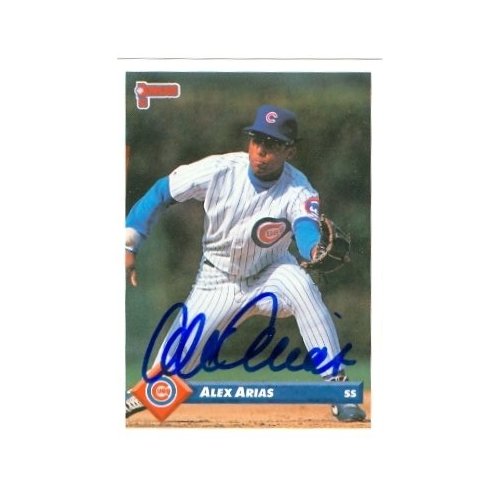
Alejandro(Alex) Arias was a utility infielder who appeared in 32 games with the Cubs and managed to have a decent 10 year career in the majors that included a World Series ring in 1997.
Arias was born in New York and grew up in the tough Washington Heights neighborhood, but hooked up with Mel Zinter, a baseball coach who also helped Shawon Dunston and Manny Ramirez get to the major leagues. Alex signed with the Cubs in 1987 and came up in 1992 where he hit for a nice .293 average playing shortstop. He would be traded to the expansionist Florida Marlins with Gary Scott for Greg Hibbard. With little power and not much speed, but an outstanding defensive ability, Arias would find his niche as a utility infielder who could fill in at short, 2nd and 3rd base. In 4 years with Florida he would hit .265, with his best year coming in 1996, playing in 100 games for the first time and hitting.277.In 1997 the Marlins won the World Series with Arias being the only player from the first year still on the team. However he would be released by the Marlins and sign with Philadelphia, where he had a solid .293 season. The next year he hit a career high .303 playing 118 games and reached career highs in RBIs, runs and hits. That would represent the high point as his numbers would decline. He spent 1 more season with the Phillies and 1 with the Padres before finishing his career with the Yankees in 2002. from there he would go into coaching with Yuma in 2005, getting a chance to manage in 2007. Arias still aspires to coach in the majors but in the meantime coaches local youth in Ft. Lauderdale.
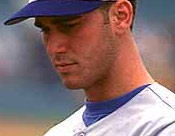
Jamie Arnold
Jamie Arnold was a pitcher who appeared in 12 games with the Cubs in 2000 with an ERA over 6. He was originally signed by Atlanta at a time when the Braves were sending many pitchers to the majors. His path to the majors was slow and he became a free agent and signed with the Dodgers where he finally made it to the majors going 2-4 with an ERA of 5.48. However when he continued to struggle he would be traded to the Cubs in 2000 for Ismael Valdez who had been a disappointment to the Cubs. Arnold didnt show much improvement, walking 19 in 32 innings. Control was a problem his entire career and at the end of the season he became a free agent. After stints with the Giants and Astros, his professional playing career ended after 2002. Not a lot of personal info on him, except that he seems to have settled in Florida where he still follows baseball.
Jim Asbell
Nicknamed "the Big Train" like Hall of Fame pitcher Walter Johnson, Asbell was an outfielder who appeared in 17 games with the Cubs in 1938, hitting an unHall of Fame like .182. Born in Dallas, Jim attended Rice University, signing with the Cubs and making his debut with the team that would win a pennant. However, Asbell didnt get a lot of chances to play and would be back in the minors the next season and would continue to play until 1940 when he retired to a life as a real estate investor in California. He would pass away from a brain aneurysm in 1967.
Jairo Asencio
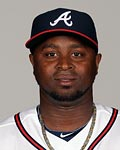
Jairo Asencio was yet another pitcher forced into action with the Cubs during the 2012 season. Asencio was born in the Dominican Republic in 1984 and signed with the Pirates as a 17 yo. After putting in his time in the minors, Asencio finally reached the majors in 2009 with Atlanta, appearing in 3 games, but in 2010 it was discovered that Asencio was signed under the name Luis Valdez and placed on the restricted list, keeping him out of the majors until 2011. He appeared in 6 unimpressive games with Atlanta with an ERA over 6 and soon found himself in Cleveland, but after a 4.91 ERA in 30 games, Asencio would be designated for assignment when the Cubs picked him up. He appeared in 12 games with the Cubs compiling a decent 3.07 ERA, however with 11 BBs in 14 innings. Control seems to be his biggest issue and that is probaly the reason he is no longer a Cub. The Brewers signed him though and I wish them the best, but I think Asencio is another one of those guys who will never quite have the career he probaly is capable of.
Richie Ashburn *******Hall of Famer******
Richie Ashburn, one of the Phillie "Whiz Kids" who played for the 1950 pennant winning teams, one of the greatest defensive center fielders of all time and one of the icons in Philadelphia, spent 2 seasons with the Cubs in the early 60s when it appeared his career was in decline. But unlike some of the players I have been featuring in "Didnt You Used to Be Famous?", Ashburn was actually fairly productive as a Cub.
Don Richard Ashburn was born in Tilden, Nebraska and signed with the Phillies in 1945, making his major league debut in 1948, right off the bat hitting .333 with a .410 OBP with 32 SBs. Over the next 12 years, in spite of not having any power, Ashburn established himself as one of the top center fielders in baseball and a great hitter, maintaining a consistency few have been able to duplicate. 8 seasons above .300, 8 seasons of at least 180 hits(including 3 200 hit seasons5 seasons with over a .400 OBP, not to mention 199 SBs as a Phillie. As late as 1958 Ashburn led the NL in hitting with an incredible .350! Following a season in which he hit only .266, the Phils thought he was in decline and dealt him to the Cubs for John Buzhardt, Al Dark and Jim Woods. He would join a Cubs team in flux, Phil Wrigley had just fired Bob Scheffing and brought back Charlie Grimm to manage a team of sore armed young pitchers, a few promising kids like Ron Santo and Billy Williams, Ernie Banks and veterans like Ashburn. Theres no doubt that this was another big name ex-All Star designed to put butts in Wrigley Field. But Ashburn suprised a lot of people by putting together a pretty good year, hitting a solid .291 with an OBP of .415 as well as scoring 99 runs for pretty bad team. The next year his number feel off drastically, but partly because he was starting less instead being replaced by kids in the newly installed "College of Coaches". He would end up on the expansionist Mets where he hit .306 and went out in style, even making the All Star team. Following the end of his playing career the next year, Ashburn would move into the broadcast booth for the Phillies and became a beloved figure in Philadelphia, not unlike our Ron Santo. In 1995 Ashburn was elected to the Baseball Hall of Fame, though there are some who question his induction. Perhaps he wasnt at the same level as the Big Three(Mays, Mantle and Snider), but he represented a greatness in the consistency and the defensive abilities. Perhaps in a more exclusive Hall he would not be there, but it is what it is. In 1997, Ashburn passed away, but he is still well remembered in Philly, a town which has always had trouble embracing even the best players. And I am proud to say that he brought some of that greatness to the Cubs, if only briefly. 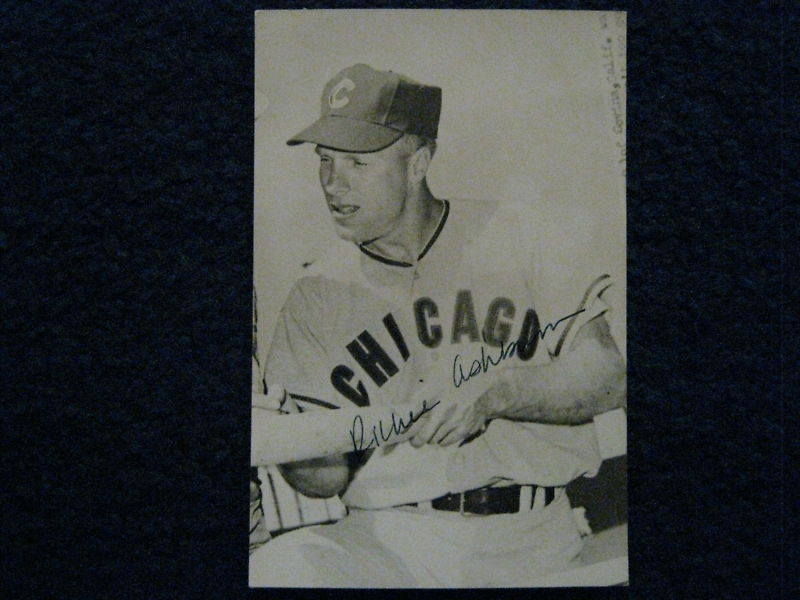
Ken Aspromonte
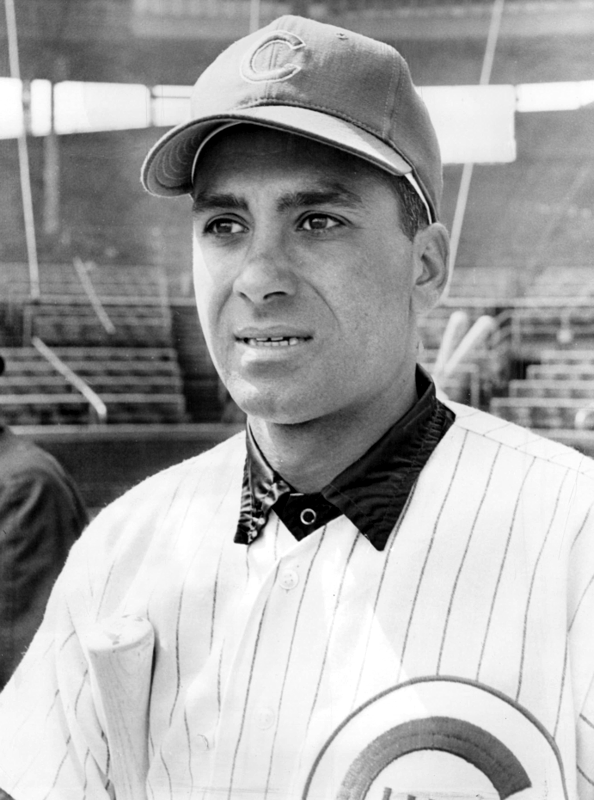
Ken Aspromonte was a utility infielder who appeared in 20 games for the Cubs in 1963, with 5 hits in 34 at bats, but he is probaly best known for being the manager who was fired to make room for the majors first African American manager in 1974.
Aspromonte was born in Brooklyn, New York. His brother, Bob had a pretty productive career himself with Houston, Atlanta and the Mets. Ken was signed by the Red Sox in 1950, but wouldnt make his MLB debut until 1957, hitting .269 in 24 games. He would play with Boston, Washington, Cleveland, the Angels and Milwaukee before coming to the Cubs. He usually came off the bench but in 1960 appeared in 121 games with the Indians and Washington, hitting a career high .288 and 10 homers. That turned out to be a fluke as he reverted to form the remainder of his career. The Cubs proved to be the final stop in his playing career. From there he would spend 3 years in Japan, returning to manage in the minors from 1969-71. Then in 1972 he was hired to replace another ex-Cub, Alvin Dark, as manager of the hapless Indians. He would win 72 and 71 games then returned for a 3rd year in 1974 where if memory serves me right, he actually had the team in contention briefly, but in spite of winning 77 games he was replaced by Frank Robinson, in what was highly publicized because Robby was the first African American to be hired to manage a MLB team(the Cubs' Ernie Banks could technically be considered the first African American to manage, but that was an unusual situation because everyone else who would have managed was kicked out of the game.). You certainly couldnt blame Aspromonte for feeling slighted because he seemed to deserve another chance, but Robinson deserved a shot at the job as much as anybody. Today, Ken is still around at 80 yo and I would assume still enjoys following the game, though I couldnt find a lot of info on him since his firing.
Paul Assenmacher
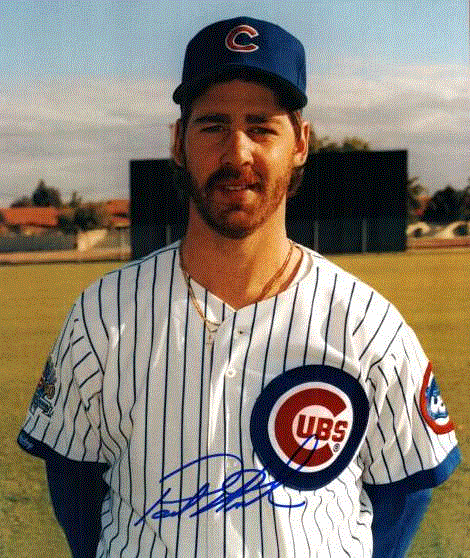
This lanky left handed middle reliever was acquired by the Cubs for the stretch drive of the 1989 season which they won the division. Although his numbers with the Cubs that season were not impressive(5.21 ERA) he did end up having a productice 4 year career with the Cubs.
Assenmacher was born in Detroit and signed with Atlanta in 1983. He made it to the big leagues in 1986 and immediately established himself as a quality middle reliever usually keeping his ERA under 4. However, in the late 80s the Braves had some pretty bad teams, so having a player like Assenmacher was pretty a luxury that was sure not to last(at some point he would burn out from overuse, theoretically, of course). So when the Braves had a chance to move him they did. Kelly Mann and Pat Gomez eventually went to the Braves in that deal. Although Assenmacher hadnt been that good, still it was assumed that he would still be valuble and he was, going 7-2 with a career best 2.72 ERA and 10 saves, another career high. Next year was virtually the same, with 3.24 and 15 saves. After the trade of Mitch Williams it seemed that Assenmacher would be getting a shot at being the closer. But then they signed Randy Myers and Assenmachers numbers tailed off to 8 saves and an ERA over 4. In 1993 he was having a more typical season(3.49 ERA no saves) when the Cubs traded him to the Yankees in a 3 team deal that nettede them Tuffy Rhodes from Kansas City. 1994 was spent with crosstown White Sox before going to Cleveland for 5 fairly productive seasons that saw him pitch in a World Series in 1997.Following the 1999 season he would be a free agent and that was the end of his major league career. He would retire following the season and now coaches a high school baseball team. Paul was your typical middle reliever, pitching for many years without much recognition, but he can be proud of the work he did with the Cubs, especially coming at a time when the closer spot was in such flux.
Toby Atwell
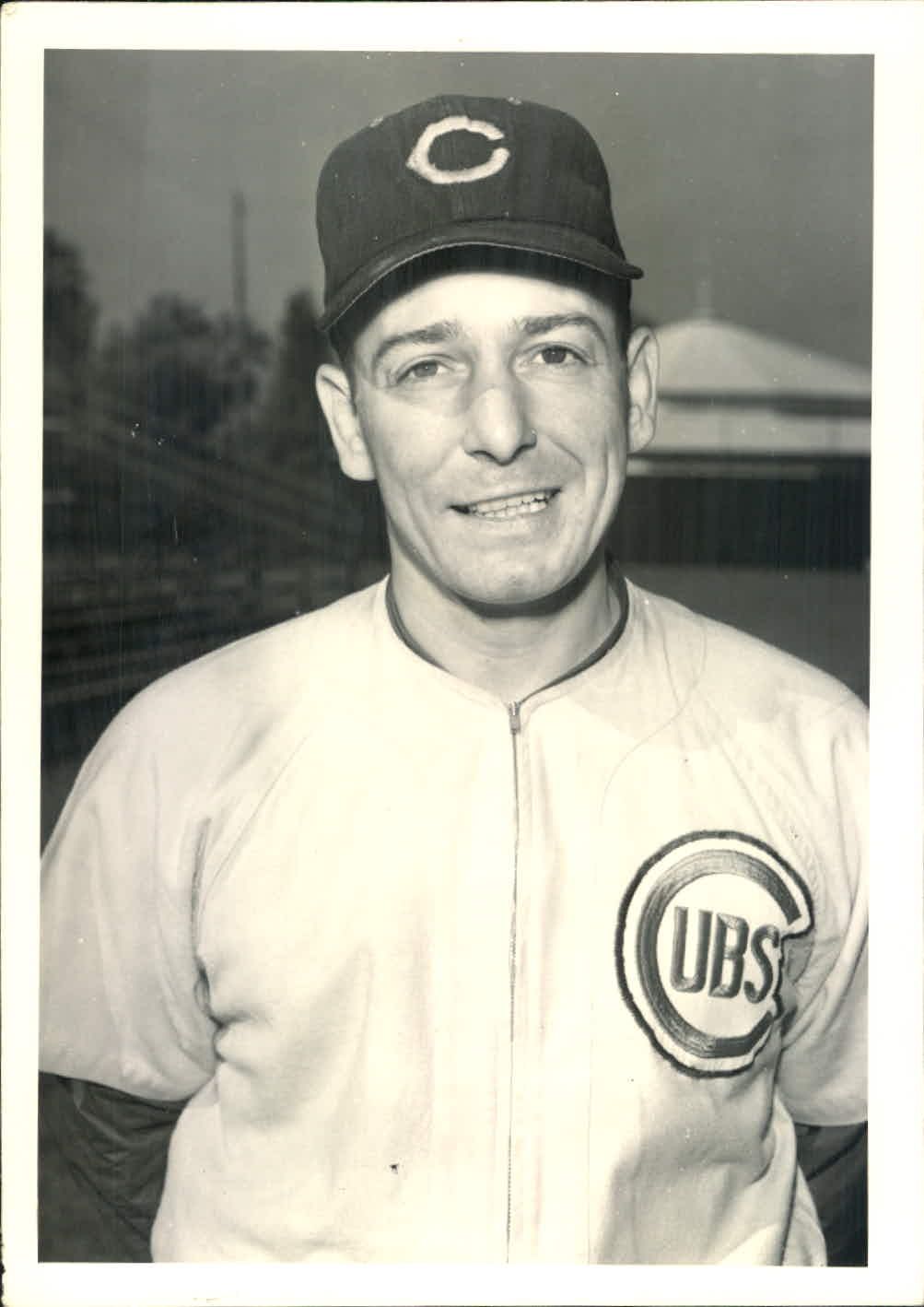
Toby Atwell was a catcher who for one season seemed to be the catcher they had been waiting for since Gabby Hartnett retired, but, alas, it didnt last and Atwell would soon be traded away.
Maurice Dailey Atwell was born in Leesburg, Virginia and after a career as a 3 sport star in high school, he was signed by the Dodgers just out of the war, which he had served in, but suffered a knee injury that kept him out of the big leagues. Atwell would hold some resentment towards the Dodgers, but if you think about it they had several promising catching prospects, including Roy Campanella, so you can hardly blame them for not rushing Atwell to the big leagues. After 6 years, he made it with the Cubs, following a trade for Carmen Mauro. Considering the kind of year Atwell had and the promise he showed, the trade certainly appeared to be one of Wid Matthews best as Cubs GM. And in 1952 Atwell took the league by storm, hitting .290 with 16 doubles and 3 triples(almost unheard of for a catcher!) not to mention a couple of stolen bases. By virtue of this, he made the NL All Star team. Considering the how mediocre the Cubs were that season 77-77 in 5th place, it was an impressive achievement. He even recieved 38 votes for MVP.
Alas, it did not last. After 24 games in 1953, he was struggling at .230 and his other numbers way down, he would be included in the trade that brought Ralph Kiner to the Cubs. The trade also brought them veteran catcher Joe Garagiola who would become famous as an announcer later. While you can question the trade for Kiner, which forced them to move Hank Sauer to right field, which he was not suited for, although Atwell did make something of a comeback in 1954, hitting .289 with 4 triples, it did not last he would hit less than .200 the remainder of his major league career, which ended in 1956. He would spend a couple of more years in the minors before calling it quits. I assume he returned to his home area because he died in Purcellville, Va in 2003. Another Cubs catcher with kind of an interesting story.
Earl Averill, Jr.
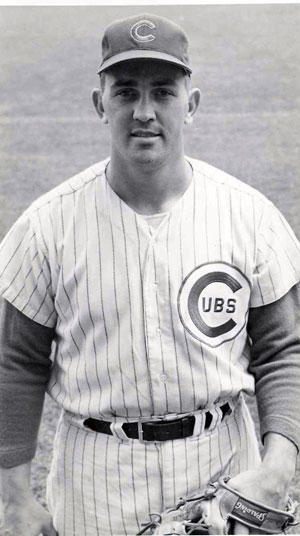
Earl Averill, Jr. is the son of HOF OFer Earl Averill, who hit .318 mostly with Cleveland.I would say this is one case where the acorn fell pretty far from the tree. After playing in college for Oregon, he signed with the same team where his father starred for many years in Cleveland. He would make his debut in 1956 where he would hit .237. After struggling to a .216 average in 2 seasons he would be dealt to the Cubs in Jan.1959 with Morrie Martin for Jim Bolger and John Briggs(not the most earth shaking trade, but then again the Cubs didnt have a lot to trade!). In 1959, Averill hit 10 home runs in spot duty, though he only had a .237 average. In 1960 he fell to 1 homer and was traded to the crosstown White Sox. In 1961 he would be selected in the expansion draft by the Los Angeles Angels, where he would hit 21 homers and .266! But in 1962 he lost his job to Buck Rodgers and ended up in Philadelphia where he hit a career high .268, but he was pretty much at the end of the line. He was out of the majors by 1964.
Bobby Ayala
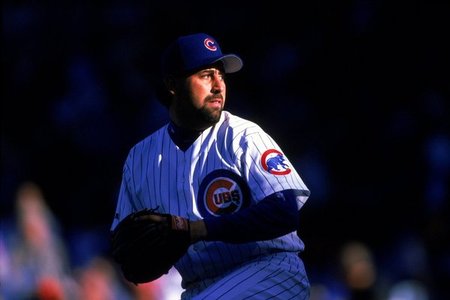
Bobby Ayala was a pitcher who appeared in 13 games in 1999 with a respectable ERA of 2.81, but for some reason it marked the end of his major league career.
Ayala originally signed with the Reds and made his MLB debut in 1992 as mostly a starter. After a year+ with Cincy, he was dealt to Seattle in the Bret Boone trade where he became a reliever and had some success with a 2.68 ERA. After 2 seasons ogf 18 and 19 saves his production began to decline and he ended up in Montreal in 1999 where he did all right but still ended up being released and ended up with the Cubs. Following a stint with a lousy Cubs team, he spent one more season in the minors before calling it quits.
Manny Aybar
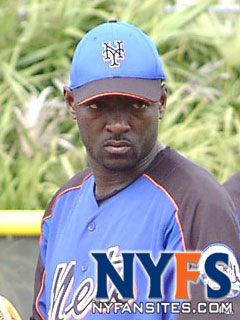
Manny Aybar was a pitcher who appeared in 17 games with the Cubs in 2001,compiling an ERA over 6 and not impressing very much. Aybar originally signed with the Cards in 1991 and made his MLB debut in 1997, mostly starting but with an ERA around 5. He would be moved into the bullpen, but didnt really show much until 2000 with Florida where he complied a 2.63 ERA in 21 games. He would be dealt to the Cubs in 2001 where his ineffectiveness would return. After being included in the deal that brought Fred McGriff to the Cubs from Tampa Bay, he wound up in San Francisco in 2002 where he was effective once again(not sure why some of these guys would be effective until getting to the Cubs then regaining it after they leave...). He even appeared in the division series where he lost his effectiveness and it would never return. He finished his major league career with the Mets in 2005.
Fred Baczewski
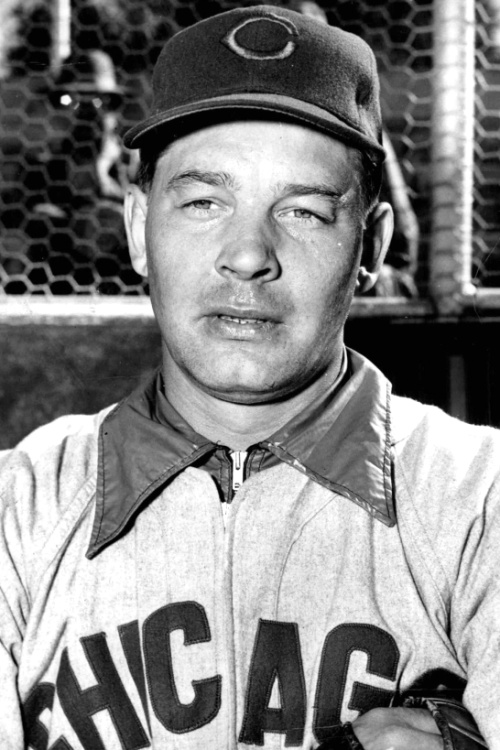
Fred Baczewski was a pitcher who appeared in 9 games with the Cubs in 1953, but it was after he was traded to the Reds that he had his biggest success. Frederic John Baczewski, who was known as "Lefty" was born in St. Paul, Minnesota, signed his first pro contract in 1947 and made it to the Cubs in 1953, with a less than stellar team managed by Phil Cavaretta. In 9 games he would accumulate an ERA over 6. Apparently the Cubs didnt think he would get better because the first chance they got, they sent Baczewski to Cincy in return for Bubba Church in what was probaly not Wid Matthews worst trade, but having to watch Lefty turn around and win 11 games as starter with the Redlegs was not Matthews proudest moment with the Cubs either. Im not sure why Baczewski had such a sudden turn around. The Reds were not an especially great team that year and there was nothing in his numbers to suggest that he would be a great starter in the majors, except that he had had some success as a starter in the minors. But, not suprisingly, it didnt last, the next year his ERA was over 5 and after one more year in the majors, he would finish his career in the minors, which would come in 1961. Lefty would end up in California where he would pass away in 1976.
Ed Baecht
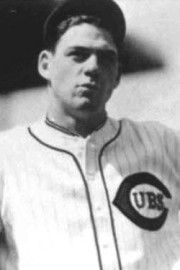
Ed Baecht was a pitcher who played for the Cubs in 1931 and 1932, not totally terrible as he had an ERA of 3.71 during his Cubs career. Ed was born in Paden, Oklahoma signed by the Phillies and made an inauspicious debut in 1926 with an ERA over 6. After 3 years with the Phillies and an ERA over 6, he returned to the minors, only to resurface with a Cubs team that was floundering under manager Rogers Hornsby. Somehow Baecht provided a positive, splitting time between spot starts and relieving. The next season he appeared in one game before he was exiled to LA for whatever unknown reason. It couldnt have been his pitching. Aside from a brief comeback in 1937, that would be the end of his career. He would settle in the small town of Grafton, Illinois where he would pass away from a heart attack in 1957.
Ed Bailey
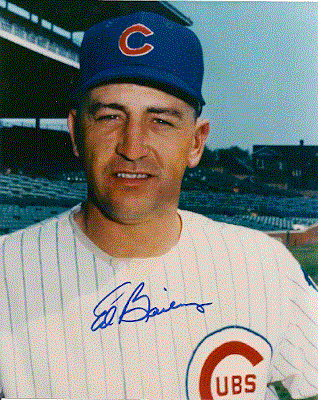
Ed Bailey was a journeyman veteran catcher who appeared in 66 games for the Cubs in 1965, in fact becoming one of the last catchers who would play regularly before the Cubs acquired Randy Hundley the following December. Bailey was a slugger who had pounded out 150 home runs in the 10 years preceding his acquisition by the Cubs though he only hit 5 more in his career.
Lonas Edgar Bailey was born in Strawberry Plains, Tennessee and attended the university of Tennessee where he was a 3 sport athlete when he signed with the Reds in 1950, however his career was interrupted by a stint in the military where he served before making his MLB debut in 1952, then hit 10 homers in sporadic play over the next 2 years while barely hitting .200. Then in 1956 had the best year of his career with 28 homers, 75 RBIs and batting .300 making the All Star team. However the next year his numbers would drop to 20, 48 and .261 and he would never quite put it all the together the way he had. Though he did average around 12 homers the remainder of his Cincy career and he would make a couple of other All Star teams. Then in 1961 after getting off to a decent start he was traded to the Giants in the deal that brought Don Blasingame to the Reds. Blasingame would be a key to the Reds pennant while Ed brought some power to the Giants. And Bailey did hit 51 homers in the 3 plus seasons he played for the Giants but by the time he was traded to the Braves with Felipe Alou the power numbers began to decline. The Cubs acquired Bailey on May 29 along with Bob Hendley and Harvey Kuenn for a fading Dick Bertell and journeyman Len Gabrielson. Considering that Hendley had that one great moment against Sandy Koufax and Bailey wasnt totally terrible, it wasnt a bad trade, although Gabrielson would have a decent career as a utility player. Bailey hit 5 homers, 23 RBIs and had a good .385 OBP in 66 games, but by the end of the season, the writing was on the wall as Chris Krug would get the majority of at bats behind the plate in September. In December the Cubs acquired Hundley and Bailey would be purchased by the Angels in January. Bailey would appear in 5 games and get released in May 1966 and that was the end of his MLB career. In the years following his retirement from baseball he would get involved in working for a local politician in his home state of Tennessee. That would be the highlight of his post baseball life and he would pass away in 2007.
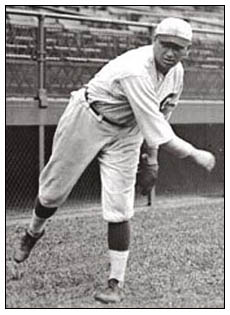
Sweetbreads Bailey
Abraham Lincoln Bailey was a pitcher who appeared in 45 for the Cubs between 1919 and 1921, mostly in relief. He was born in Joliet on February 12, 1895. Nicknamed "Sweetbreads" because of his love for the sweet meats, he signed with the Cubs and made his MLB in 1919 where he appeared in 21 games, compiling a nice 3.15 ERA, 16 games out of the bullpen. He did start 5 games but lost 3 of the 5. Returning in 1920, his numbers fell significantly to an ERA of 7.12. After 3 final games with the Cubs he would be waived and picked up by Brooklyn where he finished his career with a 4.59 ERA. Following his playing career, he would get a job working as a weighmaster for the Phoenix Manufacturing Company in his hometown of Joliet where he would pass away following a bout with pituitary gland cancer in 1939.
Gene Baker
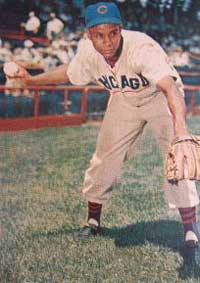
Its easy to underestimate the importance of Gene Baker to the history of the Chicago Cubs, given that he came up to the team at the same time as Ernie Banks and lost the honor of being the first African American to play for the Cubs because of an injury, but he was the very first black player to sign a contract with the Cubs, even though it took 3 years for him to actually join the Cubs. He was also a pioneer in that he was the first African American manager for an affiliated minor league team(that is, a team that was affiliated with a major league franchise). And his stint managing the Pirates in 1963 was the very first instance of a black man managing a ML game, even predating Banks' own stint 11 years later. Yet he remains an obscure figure.
Eugene Walter Baker was born in Davenport, Iowa on June 25, 1925 and signed with the Negro League Kansas City Monarchs in 1948, playing SS with them for 2 years before signing with the Cubs in 1950. Ive mentioned in other places on this website my feelings about why it took the Cubs so long for the Cubs to bring in a black player. Im not sure if it was Wrigley necessarily or other more old school baseball people in the organization who convinced him not to, but the fact remains the Cubs were one of the last teams to integrate. And when they finally did, it still took them 3 years to bring him up. He would come up with Ernie Banks, a much younger SS. Baker would not get his chance to be the first to appear in a game because of an injury. Instead Banks debuted first and would take the first steps to becoming the superstar/team icon/future HOFer he would become. Meanwhile, Baker would recover and in 1954 moved to 2nd base to accommodate the much younger Banks and they would be tagged with the nicknames Bingo and Bango(somehow, these names seem borderline racist, not sure exactly why but they do). Baker would hit a respectable .275 with 13 homers and 68 runs scored for a team that lost 90 games. The next year he hit .268, but scored 82 runs and made the All Star team. He continued to put up solid consistent numbers until May 1, 1957 when he was traded to the Pirates with Dee Fondy for Lee Walls and Dale Long. He remained a consistent player until he blew his knee out in 1958, effectively ending his days as a regular. He did get the opportunity to appear in the 1960 World Series with the Pirates which the Pirates won over the Yankees. Following his retirement as a player, he would remain in the Pirates organization as a minor league manager, becoming the first black manager for an affiliated team, then in 1963 became one of the first black coaches in the ML, following the lead of Buck O'Neill who achieved this with the Cubs in the college of Coaches though reports suggest he really wasnt allowed to do much. But Baker would be invaluble, especially in the earlier mentioned instance when Pittsburgh manager Danny Murtaugh was thrown out of a game. Baker would remain a coach, scout, manager and more with the Pirates until his retirement in 1991. Baker would pass away in his hometown of Davenport in 1999. Baker is now buried in Rock Island, Illinois. Gene Baker was a good man that, even today, Ernie Banks, Mr. Cub himself, still has fond memories of as his mentor.
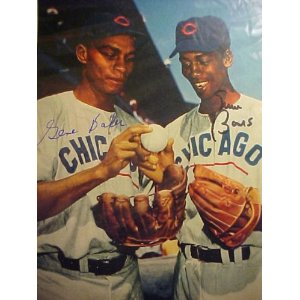
Jeff Baker
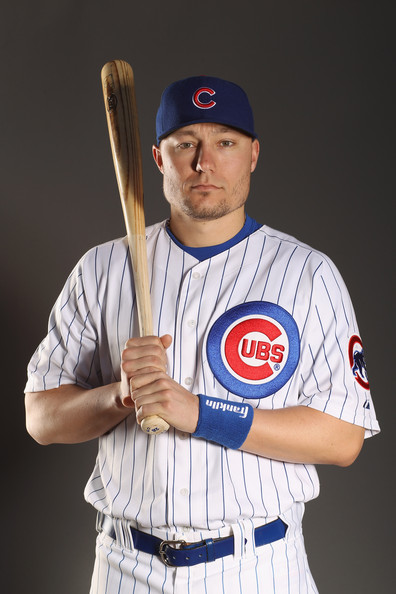
Jeff Baker was a utility player who spent 3 and a half productive seasons with the Cubs, also providing veteran leadership. Jeffrey Glen Baker was born in 1981 in West Germany, grew up in Virginia and was drafted by the Rockies in 2002. He made his MLB debut in 2005, hitting .211. After hitting .368 in 18 games he would see action coming off the bench for Colorado for 2 and half seasons hitting .257. Although he hit a career high HRs in 2008 with 12, hes never hit more than 4 since. He would be traded to the Cubs in 2009 for P Al Alburquerque. Alburquerque would end up being a decent middle reliever for Detroit but this would still be a good trade because Baker was a good utility infielder. He would hit .305 in 68 games with the Cubs. His versatility made him valuable and the leadership he brought was helpful with the influx of young players coming onto the team during this period. When he was traded to the Tigers on Aug.5 2012 he had a .280 average with the Cubs. He finished the season .239, the lowest average since 2007. As of this writing he is a FA without a team. Of course his agent is the notorious Scott Boras. Im sure he will hook on with someone. A good utility man is hard to come by. As a Cubs fan, I wish him the best.
Tom Baker
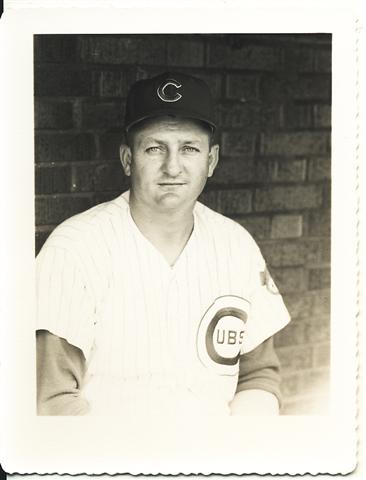
Tom Baker was a pitcher who appeared in 10 games with the Cubs in 1963.. Born in Port Townsend, Washington in 1934, he would sign with the Cardinals in 1954 but would bounce around the minors until the Cubs acquired him in May 1963. With an ERA of 3 it makes you wonder why he was gone so soon, then you look at his walks(7 in 18 IP!) and its no surprise that he would not return. He would play in the minors for 2 more years before retiring. It would appear that he went back to his home and settled down, because thats where he passed away in 1980. Another obscure name I wish there were more info on.
Paul Bako
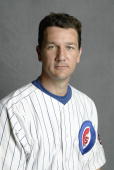
Paul Bako was a good field, no hit catcher who played for the division winning Cubs in 2003, backing up Damian Miller. He epitomized the back up catcher as he had a lengthy ML career with a number of teams without hardly ever being an everyday catcher.
Gabor Paul Bako was born in Lafayette, Louisiana in 1972, attending the university of Louisiana and getting drafted and signed by the Reds in 1993. He would make his MLB debut following a trade to the Tigers in 1998 where he hit a respectable .272 in 96 games, which sadly would be his career high. The next season he would be sent to Houston in the trade where Brad Ausmus was sent to the Tigers. Unlike Ausmus, Bakos playing time would be limited to 73 games where he hit .256. Soon he would start a nomadic existence, going to Florida, Atlanta and Milwaukee before being acquired by the Cubs in November 2002 for Ryan Gripp. Theres no denying his defensive ability. His range factor ranks 25th all time among catchers. But he only hit .218 as a Cub. Although he was coming off a career high in homers with the Brewers by hitting 4, he only hit 1 as a Cub. Still, his defense kept him in demand and following his 2 seasons with the Cubs he would go on to play 5 more seasons with 5 different teams. He even returned to the Cubs briefly in spring, 2009 but would be released at the end of the month and finished his career with the Phillies. Following his retirement from baseball he would go to work for Ahrens Investment Partners. He remains active in youth sports programs and charitable organizations in the Lafayette community. He has a wife and 2 kids.
Jay Baller
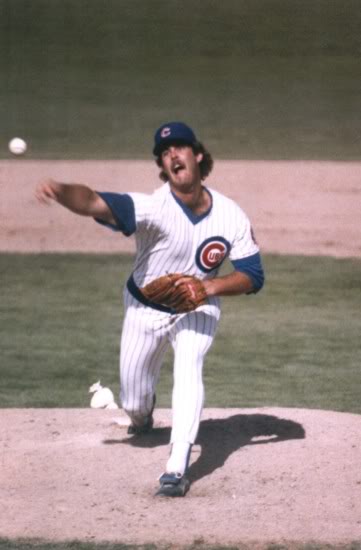
Jay Baller was yet another ex-Phillie that Dallas Green brought to the Cubs who spent parts of 3 seasons with a less than scintillating ERA just under 5. Born in Stayton, Oregon in 1960 he was signed by the Phils straight out of high school. He made it to the majors in 1982, though it would be 3 years, being part of the trade that sent Von Hayes to the Phillies, then a trade to the Cubs before he had another shot, joining the Cubs team that would be decimated by injuries to the entire starting rotation. He would appear in 20 games, mostly as a reliever with a decent 3.46. The next season would see him receiving a shot in the bullpen. However, this time he struggled with an ERA of 5.37. the next season saw him back, but with diminishing returns as his ERA ballooned to nearly 7, putting an end to his Cubs career. He would bounce around a bit before return to the majors with KC in 1990, which was a disaster with an ERA of 15 and a final stint with the Phillies in 1992. Following the end of his ML career he would play in Mexico and in Japan! Thats where his career ends in 1995. He would be in the news in 2007 for an incident involving cocaine and gun play. A less than ignominious moment for a guy who once seemed to have a bright future. Today he teaches baseball instruction in Reading, Pa.
Tony Balsamo
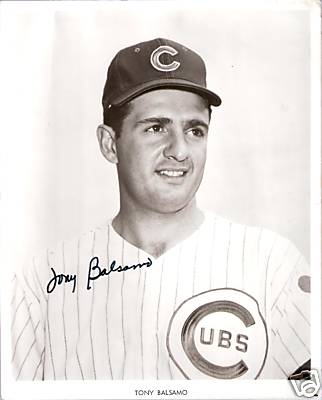
Tony Balsamo was a pitcher who appeared in 18 games for the Cubs in 1962.Balsamo was born in Brooklyn, New York in 1937. He attended Fordham University then signed with the Cubs in 1959. After working his way through the farm system Balsamo made it to the team in 1962. The Cubs were in the midst of the College of Coaches and going through a terrible season. With an ERA over 6 and 20 BBs in 29 innings Balsamo did not add much positive to a bad season. Apparently Balsamo realized his future in baseball was limited because he retired after that season. But Balsamo must be very proud that he reached the majors at all. He participates in a charity event in nearby Islip, New York involving former Cubs and Mets. He still proudly wears a Cubs uniform. Today he is the President of Donatos Seafood and Italian Restaurant.
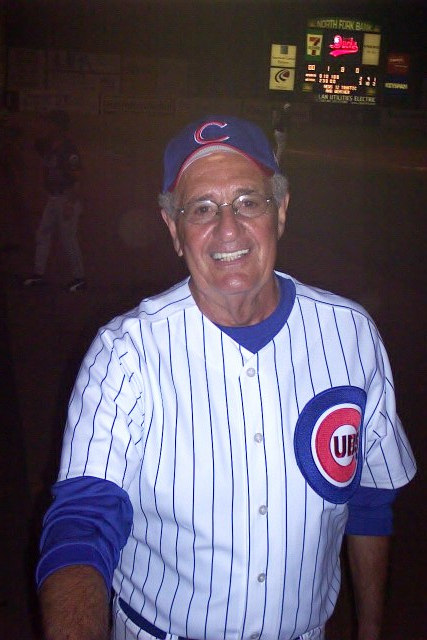
Willie Banks
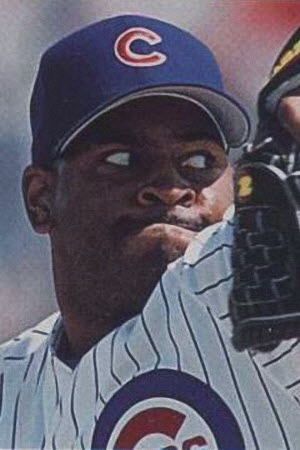
Willie Banks was a once highly touted prospect of the Twins who pitched for the Cubs in 1994-95. Willies time with the Cubs was not exactly memorable as he posted 2 of the highest ERAs of his ML career during his time in Chicago. Banks was born in Jersey City, New Jersey and was the highest player ever drafted out of New Jersey and seemed to be a cant miss prospect with Minnesota. The problem is, pitchers drafted out of high school are always risky and so it was with Willie. He zoomed through the Twins minor league system though his stock as a prospect seemed to fall the closer he got to the majors(Pre-1990: Rated #13 Prospect,Pre-1991: Rated #15 Prospect,Pre-1992: Rated #68 Prospect). He finally reached the majors for 5 games during the Twins Championship year of 1991. He would get another look in 1992 before sticking in 1993, going 11-12 with an ERA of 4 with 138 SOs. But apparently the Twins doubted his ability to get to the next level because he would be dealt to the Cubs for the 1994 season. It turned out to be a halfway decent trade for the Twins as Matt Walbeck would be a useful catcher for several years. With the Cubs he would be used as a starter at the beginning, but he really struggled with an ERA over 5.00, although he did throw his only ML shutout in a Cubs uniform.But you always sensed that this guy was a major underachiever with the Cubs. 1994 would be a disappointing year for the Cubs, though when the strike came in August, there was a sense of relief that you didnt have to watch them anymore. And so it went with Banks. When the strike ended in 1995 and baseball resumed, Willie was in the bullpen where he really floundered to an ERA over 15 in 1o games. They would trade Banks to the Dodgers in June and Willie began his life as a baseball nomad. From there he would spend 1996 in the minors, but returned in 1997 with the Yankees where he put up a nice 1.93 ERA in 5 games. In 1998 he returned to the Bronx Bombers but was unable to repeat the magic and soon found himself in Arizona where he put up his best ERA in a season of over 30 games with 3. He then became a FA and ended up in Japan! He would return to the States but didnt get back to the majors until 2001 with Boston where once again he looked great in 5 games, and returned with the Red Sox in 2002, putting up another solid 3 ERA in 29 games, but for some reason this marked the end of his MLB career. He ended up in the minors where he would stay until 2005. It was at this point that a personal tragedy caused him to leave baseball. His mother passed away and it affected him so much he would stay away for 4 years. But Banks would return to pro ball in 2009 with Newark as a player coach. 2010 would mark the end of his pro playing career. In 2012 Banks would be elected to the Hudson County Hall of Fame. He is now the Baseball Instructor at TomsRiver Sports Academy in New Jersey.
Steve Barber
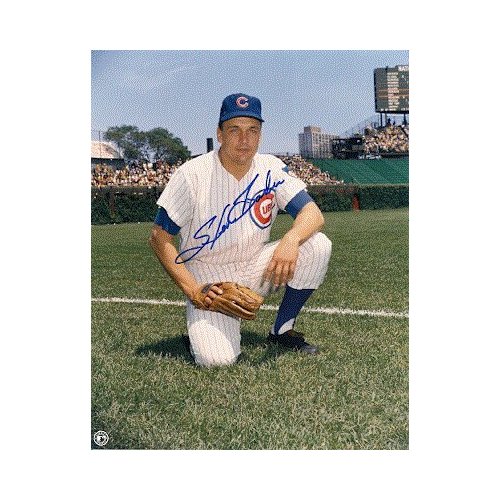
Steve Barber was journeyman veteran lefthanded pitcher who appeared in 5 games for the Cubs in 1970, compiling an 0-1 record with a 9 ERA. Barber had at one time been , along with Milt Pappas, one of the young hot shot pitchers with the Baltimore Orioles, but by the time he got to the Cubs years of arm problems had taken its toll. Barber grew up in Maryland and starred in high school and signed with the O's in 1957. In 1960 Barber made it to the big leagues as a 22 yo, winning 10 games. It was in his 2nd season that he really emerged, winning 18, throwing a league leading 8 shutouts and 2 years later won 20 games with a 2.75 ERA, making his first All Star team. His numbers dropped off sharply the next year, but in 1965 rebounded enough to win 15 games. Then in 1966 he seemed poised to win 20 again for a team that would win a pennant, but tendinitis struck and just as the Orioles were about to make their first World Series, Barber would miss out on post season. Considering that he would never get to post season afterwards, it had to be especially heartbreaking to watch his teammates celebrate a World Championship. The next season he continued to be plagued by arm troubles and would be traded to the Yankees. in 1968 he stayed healthy enough to compile a 6-5 record with a solid 3.23 ERA. But he would be left unprotected by the Yankees in the expansion draft and ended up with the Seattle Pilots in 1969. With a record of 4-7 and ERA near 5, this would mark the end of his career as a starting pitcher. After he was released by the Pilots successors the Milwaukee Brewers, he was signed by the Cubs to come out of the bullpen. He never could get his bearings with the Cubs, even though they could have used a good lefty out of the bullpen, and would be gone by the end of June. As a LHer, he would continue to get jobs, though he did struggle through 1971. After his release by Atlanta, he ended up in California where he had a couple of productive years. By 1974 he had pretty much run out of gas and following stints in the Giants and Cards organizations his pro playing career ended. In retirement he would work as a driver for children with disabilities in Henderson, Nevada where he would pass away from complications from pneumonia in Feb.2007.
Turner Barber
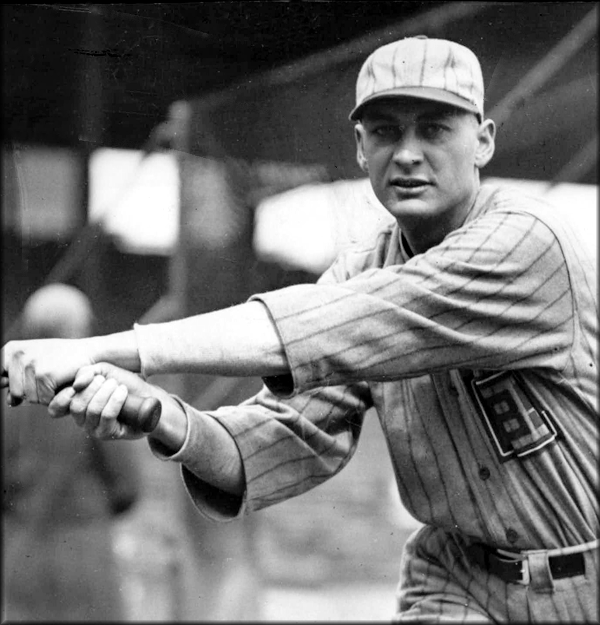
Turner Barber spent 6 seasons with the Cubs mostly as a backup OF though he did have one season as an everyday player. He hit over .300 3 times in those 6 seasons.
Born in Lavinia, Tennesse, he attended Union University then signed with Washington with whom he reached the majors in 1915, hitting .302 in 20 games. Following a less successul stint(.212) in 1916 he would be acquired by the Cubs in 1917 where he hit .214 in 7 games. But he got another chance in the Cubs pennant winning year of 1918 where he hit .236 in 55 games backing up in the OF and 1st Base. He made 2 pinch hit appearances in the World Series which the Cubs would lose to Babe Ruth and the Red Sox. The next year would be a breakthrough year for Barber as he hit .313 in 76 games. 1920 saw even more at bats though the average fell to .265. Then in 1921 Barber became a regular for the first and only time, .314 in 127 games with 142 hits, 54 RBIs and 73 runs scored. Not sure what happened the next year, I have found no evidence of an injury but Barbers at bats fell off sharply. Hack Miller had a big year, but Barney Friberg and Jigger Statz were the other OFs and didnt seem significantly better than Barber. Who knows, the 1922 Cubs were a mediocre 5th place team. It turned out to be Barbers last as a Cub, where he hit.310. But with an abundance of OFers he would be sold to Brooklyn in 1923, which marked the end of his major league career. He would remain in the minors until 1930 from there he would move to Milan, Tennessee where he would live until his death in 1968.
Bret Barberie
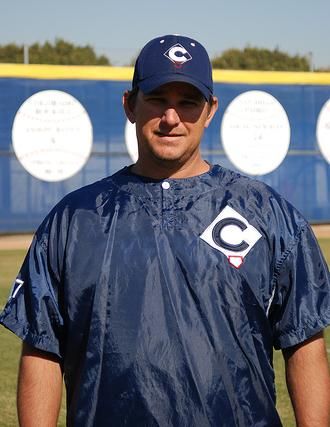
Bret Barberie was a former Olympian who appeared in 15 games for the Cubs in 1996, hitting a very un-Olympic like .034.
Barberie was a Southern Cal kid, starring at USC before joining the Olympic team in 1988. From there he was drafted by the Expos where he made his debut in 1991, hitting a nice .353. Getting a full shot the next year, he came crashing down to earth with .232. Following the season he would be drafted by the Florida Marlins in the expansion draft where he would be a charter member of that franchise. He asctually did pretty well the first 2 years, hitting .277 and .301 although he wasnt really playing everyday. He was traded to Baltimore for 1995 where his average fell to .241. From there the Cubs would be the last ML team he would play for. Following that disappointing stint he would spend 2 more years in the minors and that marked the end of his pro career. Even his marriage to LA TV personality Jillian Barberie would end in divorce. Not sure what happened to him but hopefully he has landed on his feet after s much unfullfilled promise.
Richie Barker
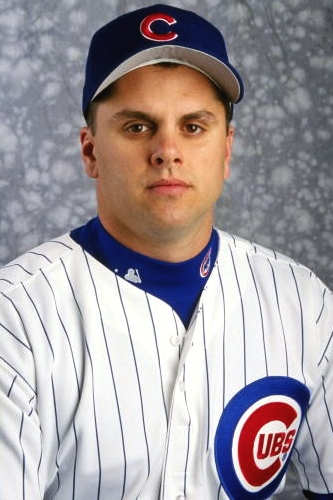
Richie Barker pitched in 5 games for the 1999 Cubs, compiling an ERA over 7. This would prove to be the extent of his ML career. Born in Revere, Massachusetts, Barker was drafted by the Cubs in 1994. After working his way up the ladder he finally made it to the majors in 1999 where he struggled with what would turn out to be a disappointing team. He would return to the minors. Where he would remain until 2000 when he called it quits. In a way Barker symbolized the lousy way the team was being run during Larry Himes tenure. In 1994 there were only 4 players that made the major leagues. The only player drafted later than Barker to make the majors was Kyle Farnsworth, who is still on a major league roster in 2012 as far as I know.
Darwin Barney
The latest 2nd baseman from the Cubs to win a Gold Glove is Darwin Barney. He represents a remarkable story of a player whose perserverance paid off in such a big way. Darwin James Kunane Barney was born in Portland Oregon in 1985, attending Oregon State University, signing with the Cubs in 2007 as a SS. However, Barneys path to the majors would have to depend on a position change with highly touted Starlin Castro expected to play SS for the Cubs. Barney would get his chance in 2010 as the Cubs the process of changing the guard. In 30 games Darwin hit .241. As 2011 arrived and the Cubs got younger, Barney got off to a hot start and helped provide the team with a lot of energy. He would hit .276. When the Cubs brought in Theo and Jed, they brought in Dale Sveum to manage. And Sveum thought Barney could be better defensively and Barney worked with coach and former ML infielder Dave McKay and the work paid immediate dividends as Darwin put together an impressive consecutive errorless game streak, a record tying 141 games. Although his offensive numbers were down. I hope he will focus on improving his hitting this year. He needs to take more walks. But I think hes capable of it. Good luck to him. Darwin has an interesting ancestral mix. Hes one-quarter Korean, one quarter Japanese, half Hawaiin-American. He is married with a 3-yo daughter. I look forward to adding more Gold Gloves to this profile and hopefully All Star appearances and hopefully a World Series as well. Good luck Darwin!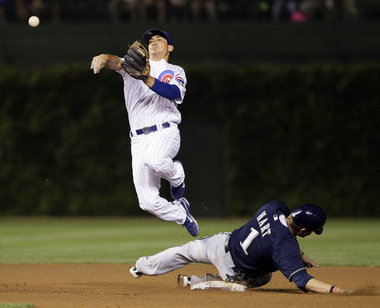
Cuno Barragan
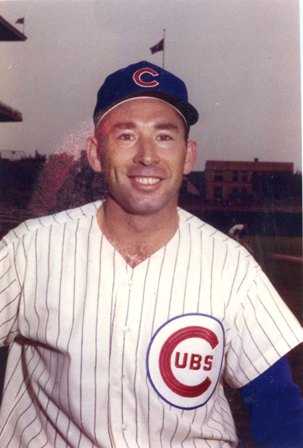
Cuno Barragan spent 3 seasons as a back up catcher with the Cubs, but he will always be remembered for hitting a home run in his first major league at bat. Facundo Barragan was born in Sacramento, California in 1932, attending Sacramento Junior College, signing with the local minor league Sacramento Solons. After a year in Idaho Falls, he served in the Navy for 2 years, then returned to play 3 more seasons before briefly retiring. After returning for 2 more seasons in the minors he would be drafted by the Cubs and joined them in 1961. In his first at bat on September 1 against Giant pitcher Dick LeMay he hit the first pitch for a homer. That would be the only home run of his career. That year he hit .214 in 10 games. Oh, yes, you can count Cuno Barragan as one of those who wasnt fond of the College of Coaches. In 1962 he appeared in 58 games, hitting .201. In 1963 he appeared in one game and that marked the end of his ML career. He did get a chance to appear in a Hispanic All Star Game that featured many of the Hispanic stars of the day including Juan Marichal, who Barragan had a chance to catch. He would retire from baseball to get into life insurance even though he longed to get into teaching and coaching, though couldnt find a position open. He would coach a local team though. He would be inducted into the Mexican-American Hall of Fame in 1973. Sacramento City college would vote him into its hall of fames in both football and baseball. Even though he had his share of disappointments, Cuno has a lot to be proud of as a pioneering Hispanic player. Now 80 years old, he still resides in Sacramento and remains tenacious.
Bob Barrett
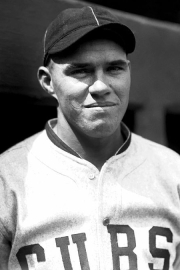
Bob Barrett was an infielder who spent parts of 3 seasons with the Cubs. Born in Atlanta in 1899, he attended high school in Massachusetts he would join Little Rock in 1922 then get drafted by the Cubs in the Rule 5 draft and appeared in 3 games in 1923, getting 1 hit in 3 ABs. Then in 1924 spent most of the season with the Cubs, playing 1st, 2nd and 3rd base, hitting .241 with 5 HRs and 21 RBIs in 54 games. After beginning the 1925 season with the Cubs he hit .313 in 14 games, but would be traded to Brooklyn to complete an earlier deal where they had acquired Tommy Griffith. Barrett only appeared in 1 game with the Robins that year, though he would spend 1927 in Brooklyn, hitting .259 with 5 Homers and 38 RBIs. Not bad numbers, but Barrett would not return to Brooklyn, instead ending up in Boston with the Red Sox in 1929 hitting .270. That marked the end of his ML career. He would spend 5 more seasons in the minors, ending in 1936. From what I would guess he must have retired to Atlanta where he would pass away in 1982. Couldnt find much info on this guy at all. But he didnt do that badly, with a .256 average with the Cubs.
Dick Barrett
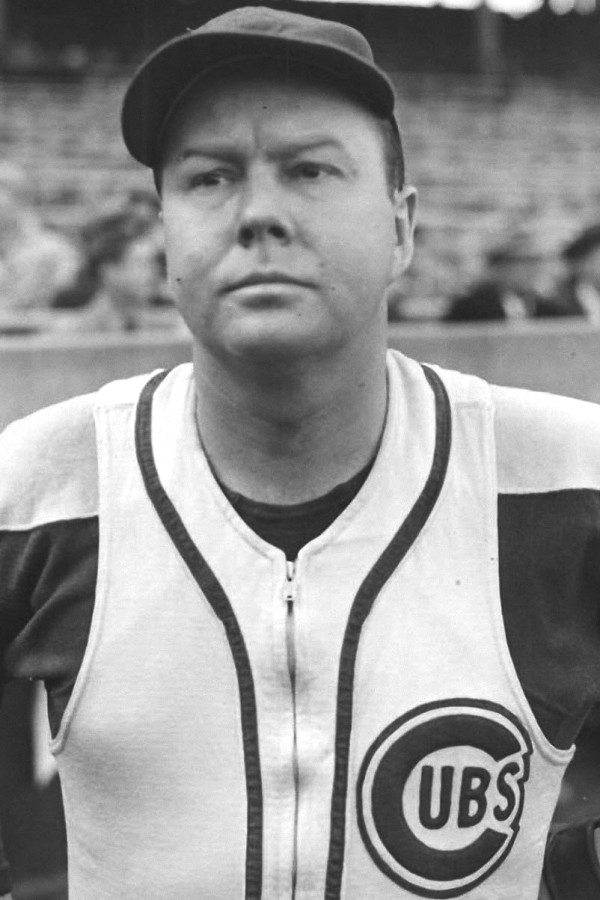
"Kewpie" Dick Barrett was a roly poly pitcher who appeared in 15 games with the 1943 Cubs, compiling a 0-4 record with a 4.80 ERA. Even though his Cubs career was very brief it appears that "Kewpie" had kind of an interesting career. Tracey Souter Barrett (not sure where the Dick came from, but I assume Kewpie was because with his 5ft9 frame holding around 200 lbs, he resembled a large Kewpie Doll!) was born in Montoursville, Pennsylvania in 1906 and attended the University of Illinois in Champaign where he played football, basketball and baseball. When he decided to play pro baseball under the name Dick Oliver in 1933-34, word got out and he would be stripped of his varsity letters. But he would sign with the Philadelphia Athletics and made his MLB debut in 1933 compiling a 4-4 record with 5.76 ERA. In 1934 he ended up with the Boston Braves where he had a 1-3 with ERA over 6. He would be dealt to Seattle where he began a long association with Seattle. He would win 20 games 7 times with Seattle before the Cubs drafted him in the Rule 5 draft. Following his unfortunate stint with the Cubs he was purchased by the Phillies where he had a 2.39 ERA with 10 wins, including 2 shut outs. Why he didnt do this with the Cubs I cant say. The next season he came down to earth a bit, still winning 12 games with a 3.86 and a shut out, but losing 18(although the Phillies of this era were pretty bad). In 1945 the slide continued as he lost 20 games with an ERA over 5. This would mark the end of his ML career. However he actually landed on his feet, returning to Seattle where he would spend parts of 3 more seasons. Of course, he was well into his 40s by this time and years of drinking began to take its toll and his numbers declined. He reached the end of his playing career in 1953. In the years following retirement he would work briefly as an announcer, in a mill, for the local parks and recreation department, a ticket taker on a ferry and finally a restaurant greeter. But in 1963 it came to light that Barrett was impoverished and suffering from diabetes.The public heard about his plight after he was arrested for shoplifting. A local newspaper held a fundraiser to help him out. But the bad health would catch up with him as he passed away in 1966. Very interesting guy. Thanks to this article in the SportspressNW. If you want to know more details about this interesting guy, check it out: http://sportspressnw.com/2012/03/wayback-machine-kewpie-dick-the-rainiers/
Michael Barrett
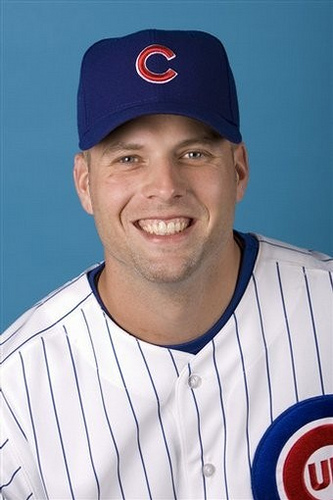
No matter what else Michael Barrett does for the rest of his life he will forever be known as the guy that punched White Sox player A.J. Pierzynski and Cub teammate Carlos Zambrano. Perhaps that is unfair when you look at the things Barrett has done off the field. In any case, Barrett spent 3 and a half seasons with the Cubs, starting off looking like a great catcher before fading.
Michael Barrett was born in Atlanta in 1976, starred at Pace Academy in Alpharetta, earning a spot with the Junior Olympic Team in 1994. Then he was drafted by the Montreal Expos in 1995 as a shortstop, but he was converted into a 3rd Baseman and catcher. He made it to the majors in 1998 as a 3rd baseman, but also caught. He hit .304 in 8 games, then followed that with .293, 8HRs, 52RBIs in 124 games. In 2000 he struggled to .214, then in 2001 he was converted to a catcher fulltime and hit .253. The next 2 seasons he hit 12 and 10 homers but seemed to have hit a wall in Montreal, which is probaly the reason he would be dealt to Oakland, then the Cubs just hours later for Damian Miller. Miller had been a productive member of the 2003 division winner, but Barrett offered more home run power, which he showed in 2004 when he hit 16 homers and drove in 65 runs with a .287 BA. In 2005 he hit 16 homers with .276 and won a Sliver Slugger. Then in 2006 he appeared to be on his way to another decent season when the Cubs played the White Sox and Pierzynski hit a home run, but as he reached home plate he got into an argument with Barrett and Michael punched him which became a famous picture. Both catchers are highly passionate and got caught up in their emotions. Barrett would be suspended for 10 games. Although he was injured late in the season, he was able to match the 16 homers of the previous 2 seasons. Barrett had hopes of improvement but got off to a terrible start and frustrations would boil over in a well publicized fight with his pitcher, Carlos Zambrano, who was also known for his volatility. The incident would help to accelerate his departure from the Cubs, which would happen with his trade to the Padres on June 20. He finished the season with 9 homers and a .244 BA. His numbers would continue to decline with the Padres then the Blue Jays. Injuries helped to contribute to his decline. In 2010 he signed a minor league contract with the Mets but when a return to the majors wasnt forthcoming he opted to become a free agent. Although there was no official announcement, it would appear his MLB career is over. While he is forever tied to the fights, he has been prominent in community work since his playing days. He has worked with Make A Wish Foundation and the Cubs Care Program to help less fortunate and sick children. He has worked with Kerry Wood and Ryan Dempster to raise money to help raise money to help Derrek Lee in the research for Lebers congenital amarosis. Barrett currently has his own non-profit organization called The Michael Barrett Foundation which is devoted to helping local childrens hospitals and other organizations that help children. He also runs several youth baseball programs including one in Hawaii. He has also worked with Cal Ripken.And with his cousin, ex-Cub Scott Fletcher he helped start Barrett Fletcher Baseball, which has run tournaments and camps for children in the local Atlanta area. Instead of focusing on negative moments from his past he has chosen to move on. I think its pretty cool. Good for you, Michael!
Shad Barry
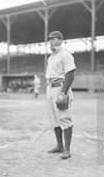
Shad Barry was a utility player who appeared in parts of 2 seasons with the Cubs, hitting .248 in 100 games. John C. Barry was born in Newburgh, New York and attended Niagra University. Barry debuted with the original Washington Senators in 1899, hitting .287 in 78 games. He would be purchased by the Boston Beaneaters in 1900. He hit .248 in 92 games before being released by Boston than wound up with the Phillies. He would hit .268 before being dealt to the Cubs for Frank Corriden. His pattern seemed to be to start off halfway decent then by a 2nd season he would struggle. After hitting only .212 for the Cubs in 1905, he wound up with the Reds where he hit .324 during the most productive stretch of his career. He hit .287 before being traded to the Cards where he hit .242. His career finally petered out with a .212 in 1908 split between St.Louis and New York. He would spend 4 years in the minors including a managerial stint before he retired from baseball in 1913. He would die in 1936 at age 58 in Los Angeles.
Dick Bartell
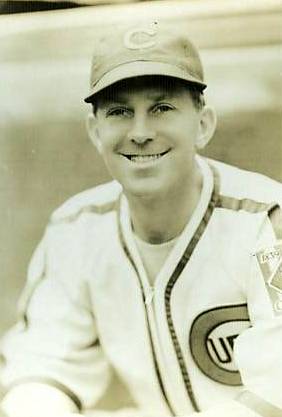
Dick Bartell was a SS as a key member of a several pennant winning Giants teams in the 1930s, however, following a trade to the Cubs, he spent such a miserable season with them, he actually welcomed a trade to the Tigers. Bartell was born in Chicago in 1907. By the time he was in high school his family had moved to California where he played baseball and would sign with the Pittsburgh Pirates. He made his ML debut with them in 1927 where he spent 4 honing his craft, hitting .300 3 times. From there he went to the Phillies where he hit .295 and established himself as a top SS. But it was with the Giants where he really made a name, playing great defense and even hitting for power for the first time. He also appeared in 2 World Series, even though the Giants lost both. Even though his numbers really declined his last year in New York, when Bartell was included in a trade that saw Billy Jurges and Frank Demaree going to the Giants, there were still high hopes for the tough SS whose nickname was Rowdy Richard. However, things got off on the wrong foot in spring training, when Bartell noticed portly sportswriter Ed Burns and Bartell joked, "What time does the blimp go up?" Burns was probaly not the kind of guy you want to joke about, since he was the official scorer at Wrigley Field and he would take every opportunity to retaliate by charging him with errors and denying him hits. Bartell hit a career low .238 in 1938 and would be sent to Detroit following the season for Billy Rogell. With the Tigers he would get into another World Series. From there his numbers would decline as he would return to the Giants as a utility player, then enlisted in the service in 1943 where he was involved in organizing teams. Following the war he would return to the Giants as a player-coach. Following the end of his playing he did some managing and coaching through 1956. In his later years he would hold down several jobs. He remained in the Almeda area until his death from Alzheimer's Disease in 1995.
Cliff Bartosch
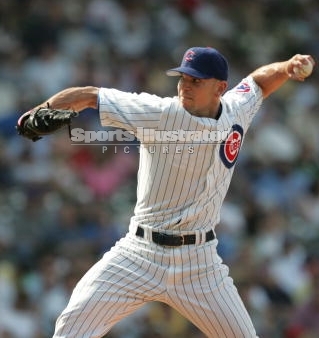
Cliff Bartosch was a left handed reliever who appeared in 19 games for the Cubs in 2005. He was born in 1979 in West, Texas and was signed by the Padres in 1998. After going to the Tigers, he would end up in Cleveland in 2004 with 4.66 ERA in 34 games. He was acquired by the Cubs in March 2005 for a minor leaguer. In 19 games compiling a 5.62 ERA. The 5 BBs per 9 Innings would doom his Cubs career though. Following a stint in the minors that would mark the end of his professional career. Wish I had more info about him.
Johnny Bates
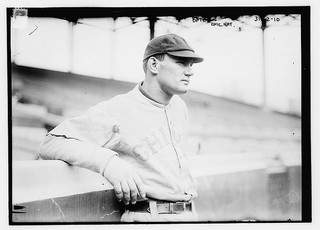
Johnny Bates was an outfielder who appeared in 9 games with the Cubs in 1914, without making much of an impression though he had actually been a productive hitter earlier in his career. He was born in Steubenville, Ohio in 1882 and made his ML debut in 1906 with Boston, hitting .252 in 140 games that included a game where he hit for the cycle. After 3 seasons of hitting around .250 he was dealt to the Phillies where he seemed to find his mojo, hitting .301 in a season and a half then was sent to Cincy where he started off great, hitting .292, but saw his numbers gradually decline. By 1914 he was down to .252 so he was released and hooked on with the Cubs. At the time the Cubs were in a battle for 1st place and pretty set in the outfield with Wildfire Schulte, Tommy Leach and Wilbur Good(though I think Good couldve been replaced) and Bates had little playing time in the 3 weeks or so he spent with the Cubs, hitting a paltry .125 before he was released in early August. It was at this point that Bates hooked on with a Federal League team in Baltimore, resurging with a .305 average. Following the season Bates did not return to the Feds. Im not sure if he had hoped to return to the majors or what, but in 1915 he was back in the minors where he spent the final 3 years of his professional playing career. From what I can guess he decided to return to his hometown and may have gotten over his baseball career and gotten on with his life. He would pass away in his hometown in 1949 at the age of 66. Sometime Id like to dig a little deeper on this guy, because I have a feeling that he had an interesting post-baseball life.
Miguel Batista
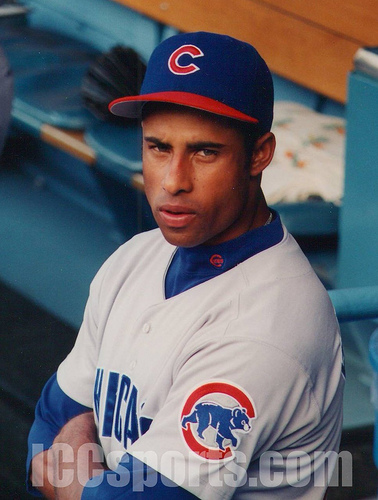
Miguel Batista is a journeyman pitcher who has managed to have a lengthy major league career, though the 11 games he appeared in with the Cubs in 1997 wouldnt exactly be considered a high point of that career.
Miguel Juerez (Descartes) Batista was born in the hotbed of baseball talent, the Dominican Republic in 1971. He would sign with the Montreal Expos in 1988 and made his ML debut in 1992 appearing in one unmemorable game(allowing a home run and 3 BBs in 2 innings). After more time in the minors he would return with Florida in 1996, compiling a 5.56 ERA in 9 games. Then the Cubs picked him up on waivers and compiling a 5.70 ERA, still walking way too many and not helping much with a really bad Cubs team. Therefore it was quite suprising that the Cubs were able to receive a serviceable major league player in return when they traded him back to the Expos for Henry Rodriguez who gave the Cubs 3 productive seasons. Of course, it provided some salve that Batista suddenly woke up to become a decent pitcher with a 3.80 ERA in 56 games. Of course he returned to struggling for the next 3 years, but in 2001 with Arizona he would be a key player in their championship run, winning 11 games with a 3.36 ERA. He would be very productive over the next few years, winning 8, 10 and 10 as a starter before a move back to the bullpen, saving 31 games. Returning to starting in 2007 with Seattle he would win a career high 16 games. He would remain a mmostly productive pitcher through 2011, being pretty much a hired gun for a number of different teams, but by 2012 he pretty much struggled with the Mets then the Braves. Hes been most successful when he keeps his walks down. As of this writing, he is a free agent though he may be able to hook on with someone. Batista has developed a reputation off the field as generous person who helps in the community. He has also written books on poetry and as well as a novel. Hes certainly come a long ways since leaving the Cubs.
Russ Bauers
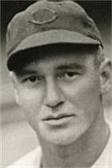
Russ Bauers was a right handed pitcher who appeared in 15 games with the 1946 Cubs. Before joining the Cubs he had spent 6 years in the major leagues as well as spent time serving his country in WWII. Bauers was born in Townsend, Wisconsin in 1914. He had an impressive high school career, including a game where he had 19 SOs in 7 innings. Following his graduation he spent time as a lumberjack and played semi-pro ball where he attracted the attention of the Phillies, who signed him to a contract. However, the semi pro team he had played for complained to the Commissioner and he became a free agent, winding up with the Pirates. Moving quickly through their farm system, he made his MLB debut against the Cubs in 1936. He became a regular member of the Pirates pitching staff where he won 13 games 2 seasons in a row, posting solid ERAs around 3 and tossing 4 shutouts. However he would struggle after that, up until 1942 when a sore arm derailed his season. But before he could have an operation that wouldve helped his arm he was called up into military service in 1943. He joined the 90th General Hospital Detachment and was in France when Germany surrendered in may of 1945. He played for an All Star team during that summer and pitched well. He returned to the States later that year and hoped to be in spring training with the Pirates, but was released in March and signed with the Cubs in July. This was the year after the last pennant and Bauers actually pitched pretty well, mostly in relief, posting a solid 3.53 ERA in 15 games. His SO to BB ratio wasnt terrible, so it seems odd that he was unable to return the next season. Perhaps he had a bad spring or maybe it was just a simple matter of being the odd man out, I dont know, the 1947 Cubs were not a great team, in any case that marked the end of his Cubs career. He would return to the minors for 7 more years with one final MLB appearance with the Browns in 1950. From what I would guess he would retire from baseball and settle down to a quiet life in Westchester, Illinois or Hines, Illinois depending on the source. He would pass away in 1995 at the age of 80.
Frankie Baumholtz
.jpg?timestamp=1357425563909)
Frankie Baumholtz is probaly best known to Cubs fans as the center fielder who was flanked on both sides by 2 of the slowest footed outfielders, not only in Cubs history but in baseball history, Hank Sauer and Ralph Kiner. But he was also a very solid hitter for the Cubs, averaging .295 in 6 seasons in Chicago. Baumholtz is also considered a pioneer in being a 2 sport athlete, having played pro basketball before coming to the Cubs.
Frank Conrad Baumholtz was born in Midvale, Ohio in 1918. Baumholtz attended Ohio University where he was an All American and helped lead the Bobcats to the NIT tournament in 1941, which in those days was THE tournament, before the NCAAs became the "in" tournament. He was so famous there he would have his number retired in 1995. Following graduation he would sign a baseball contract with the Reds, probaly because there were no major pro basketball leagues at the time, though that would change. However before he even came close to reaching the majors World War II would interfere and he would join the Navy in 1942. He served as an officer of a gun crew, then was a skipper on a mortar ship, then finally as group commander of the Saipan and Iwo Jima missions. He would be discharged in December 1945 and signed with Youngstown in the newly formed National Basketball League and returned to baseball that spring in the minors. After another season in the Basketball Association of America which eventually became the NBA, he would join the Reds and had a very solid rookie year, hitting .283, scoring 96 runs with 182 hits and finished 5th in ROY voting. The next year was also a solid one for Frank, hitting .296. However his numbers declined and he would be sent to the Cubs with Hank Sauer in what had to be as bad a trade for them as it was good for the Cubs. Baumholtz would continue to struggle in 1949, which resulted in his spending 1950 in the minors, but it turned out to be good move for him, because he was back hitting at the same level as his rookie year with a .284 average and even had 10 triples. In 1952 he hit .325, finishing 2nd to Stan Musial in the league and even finished 17th in MVP voting. Then in 1953 Baumholtz had one of the best years of his career, hitting .306, scoring 75 runs and 36 doubles. However in 1953 it was the year he was moved from RF to CF, even though he didnt have enough speed to cover all that ground, a situation that wasnt helped by the fact that Sauer and Kiner werent exactly known for their speed either. Baumholtz saw his numbers and playing time decline in 1954 and 55. He still hit .297 and .289 but would be dealt to the Phillies in 1956. Following 2 final games in 1957 his baseball career would end. Following his baseball career, he would join Marquardt Bros. where he would become director of merchandizing until he retired. He was elected to Ohio Universitys Hall of Fame in 1965 and he would remain active in the Universitys activities until his death in Oviendo, Florida in 1997.
Frank Baumann
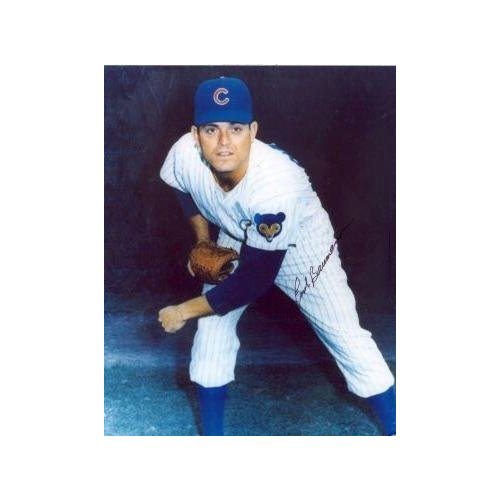
Frank Baumann was a left handed pitcher who appeared in 4 games with the Cubs in 1965. He is in that group of players who have played for the Cubs and the White Sox. In fact, at one point he was good enough to lead the AL in ERA in 1960, but by the time he got to the North Side his career was pretty much near the end.
Frank Matt Baumann was born in St. Louis in 1933. He would be signed by the Red Sox in 1952 and made his MLB debut in Boston in 1955 and made only spotty appearances through 1958, only showing brief flashes of ability. But in 1959 he appeared in 26 games, mostly in relief and posted a 6-4 W-L with an ERA just over 4. Following the season he would be sent to the ChiSox for Ron Jackson where he came into his own. He won 13 games and posted a league leading ERA 2.67 with 2 shut outs. The next year he won 10 games but the ERA went up to over 5. The next 2 years he was used as a swing man and posted ERAs in the 3s. By 1964 his numbers declined and would be sent to the Cubs for Jimmie Schaefer. He must not have show a lot in those 4 games because he would be gone. He actually spent most of the 1965 season in the Cubs AAA team in Salt Lake City. This is where his career ends. It would be nice to know what happened to him, I assume he is still alive.
Jose Bautista
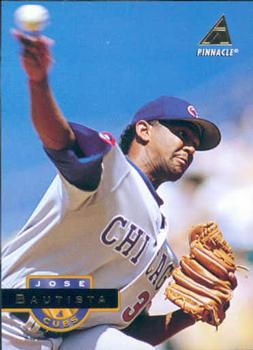
Jose Bautista was a RHP who had a couple of productive seasons mostly pitching out of the bullpen. Jose Joaquin (Arias) Bautista(not to be confused with the slugging 3rdbaseman-OFer with the Toronto Blue Jays) was born in the Dominican Republic in 1964, to a Dominican father and an Israeli mother, making him a rare Dominican Jew. He signed with the Mets as a 17 yo. After bouncing around with first the Mets then the Orioles, he came up with Baltimore in 1988 and struggled to find his niche, first as a starter, then in the bullpen. In 1992 he signed with the Cubs to minor league contract and came to spring training 1993 as a nonroster player. And suprisingly enough he won a spot on the Opening Day roster. Not only that, he had an outstanding season, winning 10 games pitching mostly out of the bullpen. His presence helped ease the loss of Greg Maddux the previous fall and played a big part in the team 84-78 record. Bautista would return the next season and while his numbers werent as strong as the previous season he was still fairly productive for a team that wasnt as good as it had been. Unfortunately 1994 would end in a devastating strike and Bautista would end up opting for free agency, signing with the Giants where all his numbers would go into a serious decline. The next year was a little better with him compiling a 3.36 ERA. 1997 saw his numbers take a big tumble again as he split the season between Detroit and St. Louis and thats where his MLB career ends. He would spend 3 more years in the minors before becoming a minor league coach in 2001. Currently he is a roving instructor for the Chicago White Sox and he remains a seriously practicing Jew.
Dave Beard
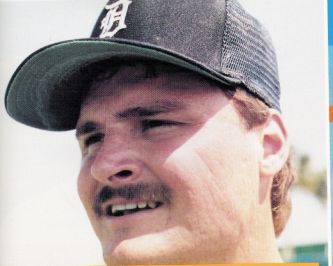
Dave Beard was a pitcher who was pressed into service with the Cubs during the 1985 season when the entire rotation went down. Unfortunately he struggled to an ERA over 6 and was gone after 9 games. Although he had a couple of productive seasons his career would be derailed by injuries. Charles David Beard was born in Oct. 1959 in Atlanta, Georgia. He would be drafted by Oakland in 1977 and made his MLB debut in 1980. The A's of the early 80s were full of young pitchers with great potential, like Mike Morgan, Steve McCatty and Brian Kingman. And Beard showed great promise, compiling a 3.36 ERA in 13 games. He appeared in 8 more games in 1981 as a call up, posting a 2.77 ERA. He would post his 2 best seasons in 1982 and 83 with 21 saves and an ERA around 4. However injuries cut down his effectiveness in 1983 and following the season he would be dealt to Seattle for Darrel Akerfelds and ex-Cub Bill Caudill. Injury issues kept his numbers down. He would be released by Seattle and after stint with the Indians he would be dealt to the Cubs where he was productive in the minors but unable to translate it into success with the Cubs. He would be released by the Cubs in November and after bouncing around a few years he would resurface with the Tigers in 1989, couldnt show much in 2 games and was released. Soon after he retired. Today he is married, has 2 kids and even a granddaughter.
Ginger Beaumont
 2.jpg?timestamp=1358581188197)
Clyde Beck
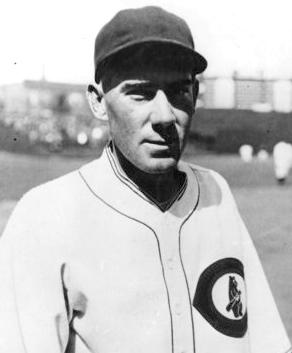
Clyde Beck was a mostly utility infielder who spent parts of 5 seasons with the Cubs. Beck was born in Bassett, California in 1900. After signing with the Cubs, he would make his debut in 1926, hitting .198 in 30 games. The next season he appeared in 117, hitting .258. Then in 1928 appeared in a career high 138 games, hitting .257 with 72 runs scored and 52 RBIs. He played mostly 2nd base and I think he got into a lot of games that year because the starting 2ndBaseman on that team was Freddie Maguire. Of course the 3rd Baseman was the equally memorable Johnny Butler. Of course that winter the Cubs acquired Rogers Hornsby and Beck would play more 3rdBase, hitting only .211 in 54 games. He hit pretty much the same in 83 games in 1930 and ended his Cub career, being sent to Cincy where he finished his MLB career with a .232 BA. After 6 more seasons in the minors, he would retire to his home in California and passed away in 1988 in Temple City.
Rod Beck
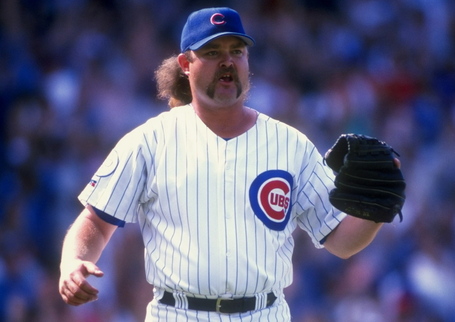
With his long flowing mullet, Fu-Manchu mustache and husky torso, Rod Beck more closely resembled a truck driver than a major league baseball player. But for several years during the late 90s "the Shooter", as Beck became known as, used this persona to his advantage as he became one of the best, and toughest closers in baseball. And for Cubs fans, they will always remember that look in a memorable playoff game in 1998 as Beck faced ex-Cub, Joe Carter in the final plate appearance of his great career as the Cubs were leading Becks previous team, the Giants. Beck would induce Carter to hit a harmless pop up to get the save and help the Cubs win the wild card in what would be the defining moment in Becks career. Sadly, that may have been the high point of a career that would end too soon and a life that would end too young.
Rodney Roy Beck was born in Burbank, Ca. in 1968. He was originally drafted by Oakland in 1986, but was traded to the Giants in 1988. He made his MLB debut in 1991, appearing in 31 games, compiling a 3.71 ERA. He became the Giants closer in 1992, saving 17 in 65 games, compiling a 1.76 ERA. Then he really hit his stride in 1993 with 48 saves, 2.16 ERA and an All Star appearance and even some votes for MVP. It appeared he might match those numbers in 1994, but for the strike. 28, 2.77 in 48 games. Imagine what if he had a full season!. But then the strike and it affected 1995 numbers as well. He had 33 saves, but his ERA ballooned to 4.45. The rest of his tenure in San Fran was somewhat down from his peak years, ERA well over 3 and saves not quite reaching 40. He needed something to energize him. So when he became a FA following the 1997, he chose the Cubs as the team he would cast his lot with. Im sure there was some trepidation. The Cubs were terrible in 1997, but they made some changes for '98, adding Henry Rodriguez, Jeff Blauser and Mickey Morandini. But it was rookie pitcher Kerry Wood and veteran OFer Sammy Sosa who helped the Cubs get going. And when Beck came into games the fans went crazy. The "Shooter" was a blue collar type of guy the fans love. And Rod put up some of the best numbers of his career, saving a career high 51 games and appearing in 81. And the 81 SOs were his best since 1993. Even though Beck didnt make the All Star team, he did get some votes for MVP. And even though the Cubs would lose in the playoffs to the Braves and their 3 headed superstar rotation(Maddux/Glavine/Smoltz) it was still a season Beck could be proud of and there would be big hopes for 1999. Except that Beck hurt his arm and they had to bring in Rick Aguilera to take his place. Even though Rod returned, he was mostly ineffective and ended up getting traded to Boston. He put up some great numbers with Boston with a 1.93 ERA, but had only 3 saves. The next 2 seasons he was solid enough but rarely closed games. Following the 2001 season he had Tommy John surgery and missed the entire 2002 season. In 2003 while trying to hook on with a major league team, he signed with the Cubs AAA affiliate in Iowa and famously lived in a mobile home outside of the teams ballpark. He would sign with San Diego where he was effective as a replacement for Trevor Hoffman, saving 20 with a 1.78 ERA. However, following that season he went through some personal issues, ending up in drug rehab. He would never be the same as he struggled in a middle relief role with an ERA over 6 in 26 games. On June 23, 2007, 2 people claiming to be friends of Becks(they turned out to be his personal assistant Tina Buchanan and her sister) were at Becks home and said that he was dead. It turned out that Beck had cocaine in his system at the time of his death. He left a wife and 2 daughters. While he was very friendly with teammates during his career, he appeared to have great difficulty adjusting to the end of his career. He didnt socialize much, though he was said to have spent a lot of time with his daughters, perhaps attempting to make up for lost time. He was also said to battling high blood pressure and a staph infection. He did love cars and was known to be very generous to people. Which makes it even sadder because he seemed like a really good guy, in spite of his drug issues. This is one ex-Cub who will be missed. RIP, Shooter....(thanks to sportsecyclopedia for an excellent article about his post playing career, heres the link if you are interested,http://sportsecyclopedia.com/memorial/07/beck.html)
Heinz Becker
Glenn Beckert
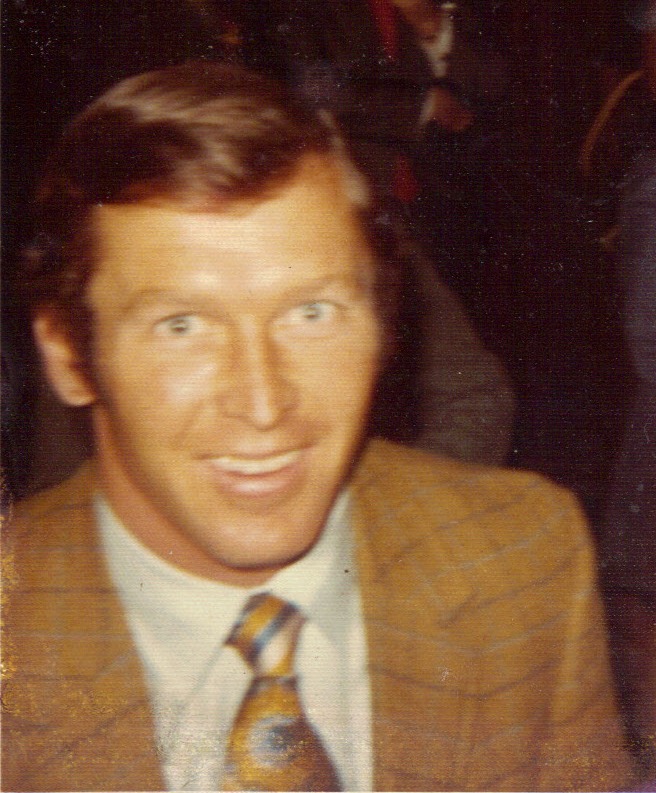
Check out my Hall of Favorites for my profile of Glenn Beckert
Fred Beebe
.jpg?timestamp=1362628985790)
Jeff Beliveau
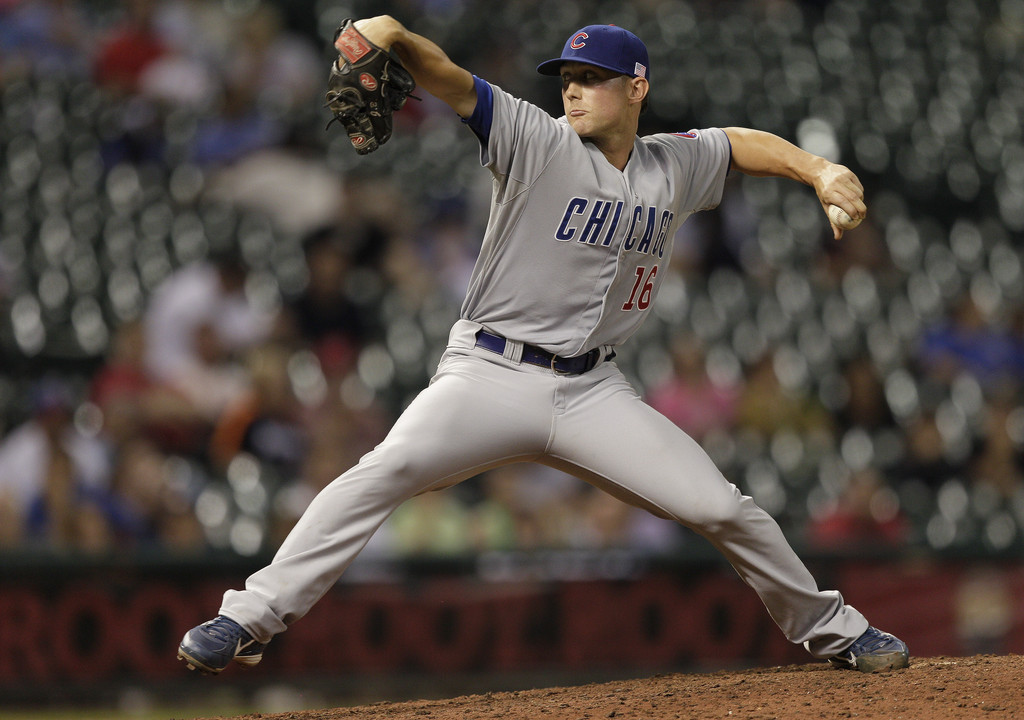
Jeff Beliveau was just another of several young pitchers who were forced into service by all the injuries and trades during 2012. Beliveau was born in Providence, RI in 1987 and attended Florida Atlantic University before signing with the Cubs in 2008 where he worked his way up the farm system gradually. Though he was considered a mid-level prospect, instead of being able to continue to improve in the minors he would be called up in July where he seemed to show some potential, however 12 BBs in 17 innings does not make for great promise, though the ERA was a not totally terrible(considering how some of the other were really struggling) 4.58. Apparently the Cubs figured a change of scenery might help him so they let Texas pick him off waivers where I certainly wish him the best in his future endevors.
George(Jorge) Bell
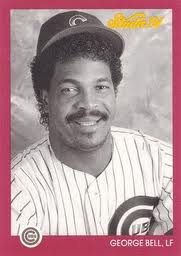
For good or for bad, George Bell will forever be known as the guy who the Cubs traded for Sammy Sosa in what was one of the best trades in Cubs history. And his time in Chicago did not go well. But people forget that he was AL MVP in 1987 and he did have a productive ML career. George Antonio (Mathey) Bell was born in 1959 in the Dominican Republic, signed as a 19 yo with the Phillies. He was drafted by the Blue Jays in the rule 5 draft. He hit 5 HRs with a .233 in 1981. After struggling a couple of years, he made his first impression in 1984 with 26 HRs, 87 RBIs and .292 BA. He would improve his power numbers each year for 4 years until in 1987 he hit 47 HRs and 134 RBIs and .308 BA. Those numbers helped earn him an MVP award. However those numbers took a big drop in 1988 to 24, 97 and .269. The HRs would drop again 1989, but his RBIs went up and his BA to .297. In 1990 his numbers remained static with 21, 86 and .265. Following the season he chose free agency. One of the things that hurt him was his reputation as a surly person. But when he signed with the Cubs it looked like a marriage in heaven. It was thought Bell might be able to take advantage of Wrigley short distances. But it would not work out that way. Bell never did benefit much, indeed it seemed like it hindered him more than helped. At seasons end, although he had decent numbers, .285 BA, 25 HRs, still they were far below what was expected. And compounding that, Bell never seemed happy with the floundering Cubs. So when the Cubs had the chance to move him they took it. On March 30, 1992, Bell was sent to the White Sox for P Ken Patterson and talented but tempermental OF Sammy Sosa. And, well, you know what happened to him. Bell spent 2 decent if unspectular seasons with the Sox. Released following the 1993 season, Bells MLB career ended. He has returned to the DR where today he is involved with the national team which is participating with the World Baseball Classic. He was also recently elected to the Canadian Baseball Hall of Fame with Tim Raines.
Les Bell
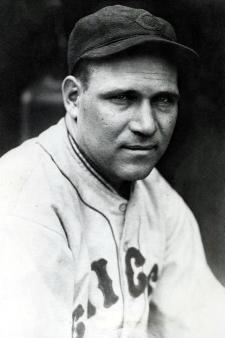
Mark Bellhorn
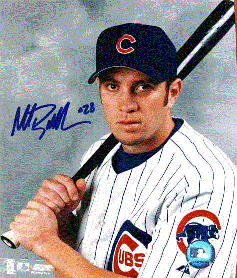
Mark Bellhorn was a journeyman infielder who spent a season and a half with the Cubs, going from having an incredible season where he hit 27 homers to struggling to keep his average above the Mendoza line. Yet he managed to overcome that season to help Boston break their supposed "curse" by winning the World Series. Through it all his inability to show more patience at the plate would keep him from having a better career. Indeed, only 4 years removed from winning a ring he would be out of MLB. Mark Christian Bellhorn was born in Boston in 1974, attending Auburn University then signing with Oakland in 1995. Within 2 years Bellhorn would be in the majors, hitting .228 with 6 HRs, but 70 SOs in 68 games. The next year he would hit .083 in 11 games. After 47 more games not reaching .160, Bellhorn would be traded to the Cubs for a minor leaguer. The Cubs were having issues finding a 2nd Baseman and when Bellhorn became a suprise in spring training he would be a real revelation and he began slugging home runs. And he would set several records for switch hitters, including becoming the 2nd ML player to hit homers from both sides of the plate in one inning. He would end up with 27 homers, scoring 86 runs and hitting .258. But on the negative he struck out 144 times. However, in 2003 he got off to a terrible start, hitting only .209 with only 2 HRs. He would be traded to Colorado for Jose Hernandez in what would set up one of Jim Hendrys key moves of that division winning season. Meanwhile Bellhorn continued to struggle and would be dealt to Boston. Because of injuries throughout Bostons infield, Mark would get another chance and he would put together a season that was probaly better than 2002:.264, 93 Runs, 82 RBIs. And he would cap it off with a memorable home run in Game 1 of the World Series. That would be the high point of his career as his propensity to strike out derailed his ability to produce regularly. By 2006 he was with San Diego where he hit only .198 and struck out 90 times in 115 games. Following 13 games with the Reds where he only hit .071 his MLB career came to an end, though he kept trying to get back bouncing around with several teams. By 2009 he had reached the end of his pro career. Following his ML career he went into business with several donut shops. As far as I know he still lives in the Boston area.
Francis Beltran
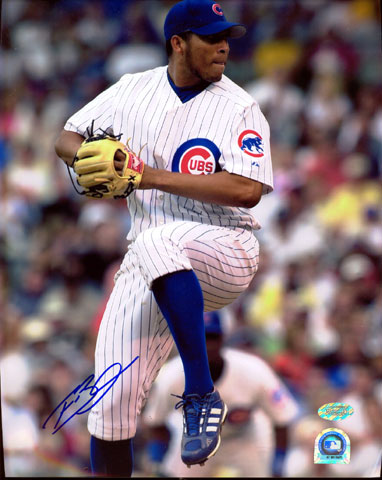
Francis Beltran was promising pitching prospect with the Cubs who appeared in 45 games, though injuries would keep him from ever really fulfilling his potential. Francis LeBron Beltran was born in Santo Domingo in 1979. He signed with the Cubs in 1996. He gradually worked his way up the Cubs system establishing himself as a top prospect before reaching the big leagues in 2002. In 11 games he struggled to a 7.50 ERA with 16 BBs in 12 innings. In 2003 injuries kept him out of the majors though he would get back in 2004. He would appear in 34 games with an ERA of 4.63 and cut his walks significantly. However he would be part of the 4 team trade that saw Nomar Garciaparra come to the Cubs, with Beltran going to Montreal. He would appear in 11 games with a 7.53 ERA with injuries having a negative affect on his numbers, though he did appear in enough games that he would be accorded the honor of being the last pitcher to appear in a game as an Expo as the team would move to Washington the next season. However in injuries would keep him out of the major leagues the next 3 years. With the Tigers he would appear in 11 games with a 4.85 ERA, though he would have trouble staying around and spent a lot of time in the Mexican League and independent leagues. His professional career reached an end when he was released by Baltimore in March of 2012. As far as I know it appears his playing career has come to an end at the age of 33. Its a shame what injuries did to his career.
Alan Benes
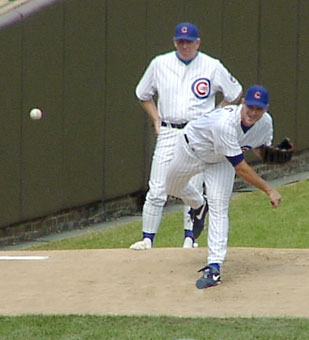
Alan Benes was a local area pitcher who appeared in 10 games for the Cubs in 2002 and 2003, though arm problems would derail a promising career.
Alan Paul Benes was born in Evansville, Indiana in 1972 and attended Lake Forest high school as well as Creighton College and would follow in the footsteps of brother Andy as professional baseball player.Unlike Andy, who had a very productive and successful pitcher, winning 155 games in 14 seasons, Alan would have a tougher go. He would make his debut with St.Louis, compiling an 8.44 ERA in 3 games, though the 20 SOs in 16 innings was impressive. The next season he would win 13 games and 131 SOs, though the ERA close to 5 was a little high. In 1997 he appeared to have made a breakthrough with 160 SOs, 9 wins and a solid 2.89 ERA, but injuries cut short his season as well as 1998. After a brief return in 1999 he was back in 2000 but out of the bullpen and no longer the SO pitcher he had been. He would struggle the remainder of his tenure with the Cards and was signed by the Cubs in 2002 and put up some decent numbers starting, posting a 4.35 ERA. He returned in 2003 and had a good 2.16 ERA in 3 games before being sent to Texas where he struggled with more arm problems. Though he would continue to try to come back until 2007 when he retired. Today he is a minor league instructor with the Cards. In 2011 he was elected to the Creighton Athletic Hall of Fame. Benes is yet another example of how tricky it can be to be a major league pitcher.
Butch Benton
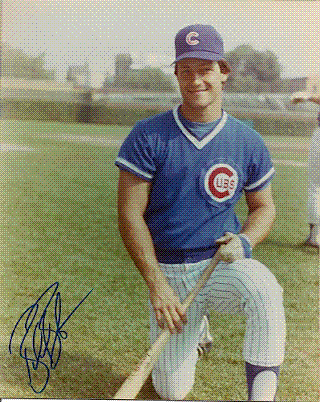
Butch Benton was a catcher who appeared in 4 games with the Cubs in 1982, batting 7 times for a .143 average. Alfred Lee Benton was born in Tampa, Florida in 1957 and attended Godby High School in Tallahassee, drafted by the Mets and made his debut as a highly touted prospect in 1978. He would appear in 16 games over 2 years, batting an unimpressive .120. After struggling for 3 years he would dealt to the Cubs in a conditional deal. However he wouldnt get much of a chance with former fellow Met prospect Jody Davis having emerged as the Cubs starting catcher. Following the season he would be traded to Montreal for future White Sox manager Jerry Manuel(though he would never play for the Cubs). After bouncing around a bit, Benton actually got one last chance with Cleveland in 1985 where he hit .179 in 31 games. That would mark the end of his MLB career though he would attempt a comeback in 1991 which would fail. He would retire and settle in Ocala, Florida where today he is prominent in charitable causes, like the MLBPAA, which helps former ball players as well as the KinderVision Foundation, which provides free baseball clinics to children 7-15. Nice to see another ex-Cub who is doing good things in retirement from baseball.
Jason Bere
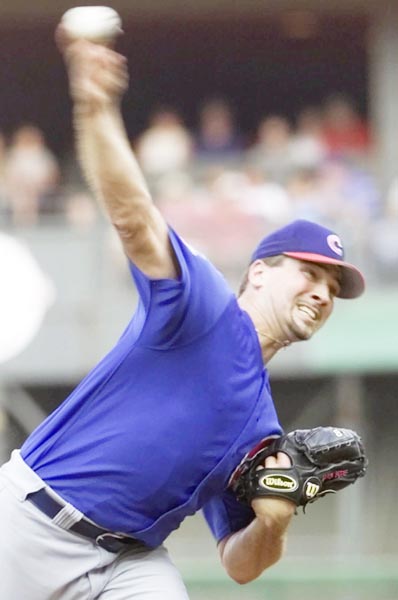
Jason Bere was a former White Sox prized prospect who spent 2 years with the Cubs, winning 11 games in 2001, but ultimately injuries would short curcuit his time on the North Side like they did on the South Side and would eventually end his career.
Jason Philip Bere was born in Massachusetts in 1971, eventually signing with the Chicago White Sox in 1990, reaching the major leagues in 1993, joining a group of talented young pitchers led by Jack McDowell, Alex Fernandez and Wilson Alvarez. He would win 12 games with a solid 3.49 ERA, finishing 2nd in Rookie of the Year voting. The next year Bere was 12-2 and an AllStar when the strike came. The next season he suffered the first of what would be a long string of injuries. He would return the next season but lose 15 games with a 7 ERA. The remainder of his time with the Sox would injuries punctuated with brief periods where he could pitch but not effectively. After beginning his career 24-7, he would go 15-25 the rest of his Sox career. On July 16, 1998 he would be released by the Sox. 5 days later he signed with the Reds. He would go 3-2 with a 4.15 ERA and seemed to ready to return but arm problems continued to plague him as he went from the Reds to the Brewers. In 2000 he pitched in enough games to win 12, but his ERA remained too high. However in 2001 he joined the Cubs and appeared in a career high 32 games for them, winning, striking out a career high 175 and posting a respectable 4.32 ERA. It looked like Bere was finally back, but again arm problems resurfaced and in 2002 Bere struggled to a 1-10 record. Following the season he signed with Cleveland where he spent the final 3 years of his career trying to get healthy. By 2005 he reached the end of the line and retired, leaving behind much unfulfilled potential. Bere had the misfortune of reaching the peak of his career just as the strike hit. He seems resigned to his fate though he would remain in baseball, becoming an assistant to the GM in Cleveland.
Jason Berken
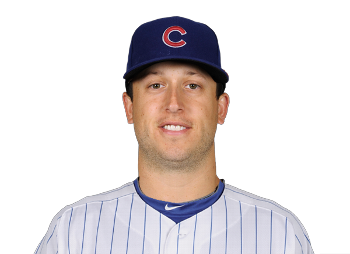
Jason Berken was yet another of many journeyman types of pitchers who was given a chance to pitch for the 2012 Cubs. Unlike some of the others, however, Berken had already had some success at the major league level. Born in Green Bay, Wisconsin, Berken attended Clemson, a successful stint which ensured he would be signed to a MLB contract, which he was, with Baltimore. After moving through the Oriole system he made his debut in 2009. He would struggle to a 6.54 ERA with 19 HRS allowed in 24 games! But he took the bulls by the horns as he emerged as a top notch middle reliever with a 3.03 ERA in 41 games. He looked very impressive and appeared to have a big future in Baltimore until he struggled to a 5.36 ERA in 40 games in 2011. The longball bugaboo seemed to continue to haunt him as he allowed 10 HRs in only 47 innings. The next year started with Jason in the minors barely getting another chance when the Cubs picked him up in September where he started 4 games compiling a not terrible but not overly impressive ERA of 4.82, though the 3 HRs he allowed in 18 innings was actually his best HR rate since 2010. The Cubs must have seen something because they brought him back for 2013, though as of this writing(march 2013) he hasnt done much in spring training to encourage anybody that it was a good decision. Im guessing, at the very least he will be back in the minors for 2013. But who knows, maybe he can find that 2010 mojo again someday.
Joe Berry

Joe Berry was a 37 yo pitcher who appeared in 2 games with the Cubs in 1942 then had some moderate success after leaving the Cubs. Known as "Jittery" Joe for his herky-jerky pitching motion, Jonas Berry was born in 1904 in Huntsville, Arkansas. He signed with Gulfport in 1927 and would spend the next 15 years toiling in the minors before signing with the Cubs in 1942. With the Cubs he would pitch 2 innings, allowing 7 hits and 4 runs for an ERA of 18.00. After another year in the minors he would be sold the Philadelphia A's where he put together a solid year out of the bullpen, winning 10 games and a league leading 12 saves with a 1.94 ERA. 1945 would see him put together another good year with 8 wins, 2.35 ERA and a league leading 52 games. The next year would find him splitting the season between the A's and Indians, posting a decent 3.22 ERA. However that would mark the end of his MLB career for whatever reason. I couldnt find anything about any injury, he might have just been the victim of a numbers game. He would pitch a few more years in the minors before calling it quits. He did do some managing near the end of his playing days, compiling over a .500 record. Sadly he would die in an automobile accident in 1958.
Damon Berryhill
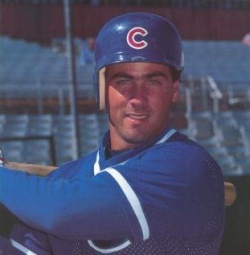
Back in 1987 Dallas Greens efforts to build up an empty Cubs farm system began to bear fruit. The first youngsters were beginning to show up in the major leagues, though because of injuries, most of these kids were clearly rushed. Damon Berryhill would be the first of several talented young catching prospects that would arrive in quick order. My memories of Damon were that he was a fairly decent defensive player, but he never did learn how to hit major league pitching consistently, though I think he did also have injury issues. Berryhill was literally a California beach boy, having been born and raised in Laguna Beach. But unlike many of the others he chose baseball over surfing and following a stint at Orange Coast College, he would be drafted and signed by the Cubs in 1984. He worked his way up the system to make his MLB debut with the Cubs in 1987. With Jody Davis still playing at a high level it didnt appear that Berryhill would get his chance right away. However by 1988 it was clear that Davis was losing it as his number declined and Damon got his chance, hitting .259 with 7 HRs. The fact that he was a switch hitter didnt hurt either. Then Davis was gone and Berryhill hit .257 as the Cubs won the division, however Damon wasnt around to help the Cubs as they lost in the playoffs as he suffered a torn rotator cuff which would seriously affect his ability to hit consistently. Berryhill did not return until late 1990. He would continue to struggle through when the Cubs finally gave up on waiting and they traded him to Atlanta in the deal that brought them the colorful Turk Wendell. With Atlanta he finally seemed healthy and comfortable, hitting 10 HRs though the BA was still only .228. The next season was basically the same, hitting 8 HRs with .245. He was at the point where he was essentially a back up and he would sign with Boston when Atlanta wanted to bring in Javier Lopez and playing in 82 games had the highest average of his career, .263. This is where the injuries would take its toll as he missed the entire 1996. From there he would bounce around a bit as he tried to return to the majors. A 73 game with the Giants would mark the end of his major league playing career. By 1998 he had reached the end of the line. Today he is a minor league manager with the Dodgers. With the trend of former MLB back up catchers like Mike Scioscia and Bruce Bochy winning championships, it may only be a matter of time until Berryhill is given his opportunity. Damons wife, Anne is very active in helping wives of pro athletes with marriage concerns. Considering they have been married 25 years, she must know something about the issue.
Dick Bertell
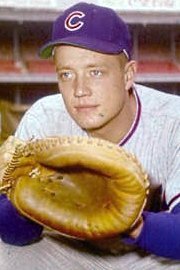
Dick Bertell was a pretty good defensive catcher with a strong throwing arm who spent 6 seasons with the early 60s. Although he showed promise early as a hitter he never quite found the consistency to make himself a starting catcher. Born in Oak Park, Illinois in 1935, he attended school in Iowa, starring at Iowa State before signing with the Cubs in 1957. He would make his debut in 1960, then in 92 games in 1961 he hit a respectable .273 and driving in 33 runs. The next year in 77 games he hit a career high .302. That earned him the opportunity to play more, but his hitting didnt improve in 2 seasons over 100 games, staying in the .230s. When he got off to a slow start in 1965 he would be dealt to the Giants that brought the Cubs Ed Bailey.He would in appear in only 22 games with the Giants before he would eventually be traded back to the Cubs for Don Bryant. After only 2 more games he would be released by the Cubs in 1967. That marks the end of his baseball career. Following his playing career, he did do some work building cradles with ex-Cub teammates Dick Ellsworth and Don Elston. Bertell died following a bout of influenza in 1999. He would be elected to the Iowa State Hall of Fame in 2000.
Mike Bielecki
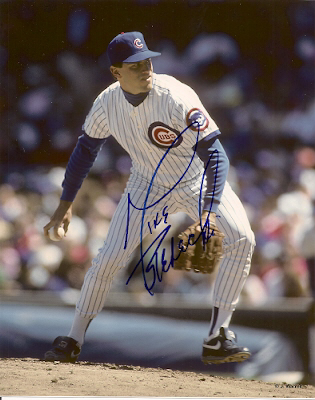
If you were to look in the dictionary under "career year" you just might see Mike Bieleckis 1989 as one of the definitive career years. For most of his career Bielecki was a journeyman pitcher, but in 1989 Mike came out of nowhere to win 18 games, for one season joining the likes of veteran Rick Sutcliffe and up and coming Greg Maddux as key starters on the Cubs. And its not like Bielecki went back to complete obscurity, he did have some success as a middle reliever with Atlanta during the early part of their great run of division titles. Michael Joseph Bielecki was born on July 31, 1959 in Baltimore and would be drafted out of Valencia Community College in Florida in 1979 by Pittsburgh. Even though the Pirates had fallen on hard times after years of great success, it still took Mike 5 years to make his MLB debut in 1984. He would appear in 16 games his first 2 years without being very impressive, but he was very wild, walking 31 in 49 innings. He would continue to struggle the next 2 seasons to an 8-14 record, ERA close to 5. The Bucs finally gave up on him by trading him to the Cubs on March 31 1988 for minor leaguer Mike Curtis. Bielecki spent 1988 mostly coming out of the bullpen, compiling a 3.35 ERA, though he did start the first night game in Wrigley Field history. 1989 was season full of uncertainty for the Cubs. After Sutcliffe and Maddux there were questions about the rotation, Scott Sanderson was always a risk and Paul Kilgus did not excite a lot of people, so when Bielecki won a spot in the rotation there wasnt a lot to give people confidence. But there were more than a half a dozen players on that team that had career years, including rookies Jerome Walton, Dwight Smith, Lloyd McClendon, Les Lancaster, Mitch Williams and Gary Varsho. Bielecki would go 18-7 with a 3.14 ERA and 3 shutouts and 147 SOs in helping the Cubs win the division though they couldnt beat a Giants team that was just too good for them. Sadly the team as a whole was unable to repeat such impressive numbers and Bielecki especially, posting 8-11 with an ERA near 5. In 1991 he actually managed a decent 13-11 record, but his ERA was 4.50. He would be traded to Atlanta in the same deal with Damon Berryhill for Yorkis Perez and Turk Wendell. With the Braves in 1992 he appeared in 19 games with a good 2.57 ERA but only 2-4 record. Following the season he signed with Cleveland where he struggled to an ERA over 5. but following that season he returned to Atlanta where he appeared in 19 games mostly in relief to a 4 ERA. Following the strike he went to the Angels where struggled again with an ERA near 6. Once he returned to the Braves where he spent the final 2 seasons of his MLB as a reliever, compiling a good 2.63 ERA then a less stellar 4.08. Today he is involved many causes in his hometown, including the Sharing Hearts Foundation. Today Bielecki is an analyst for Fox Sports.
Larry Biitner
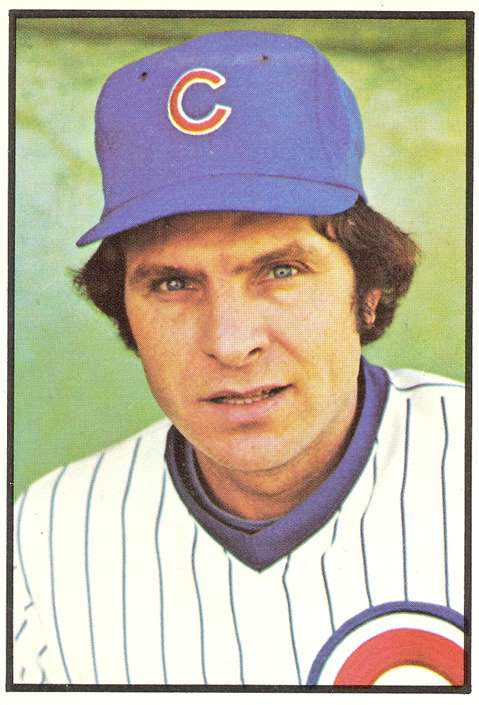
Larry Biitner was a somewhat defensively challenged 1st Baseman-Outfielder who spent 5 seasons with the Cubs in the mid-70s, though he may be best remembered by Cub fans for his pitching stint on July 4, 1977 where he will forever own an ERA of 40.50! But Larry deserves better than that. He was actually a decent hitter, compiling a .273 with the Cubs and having the 3 best seasons of his career in Chicago. Not too bad for a player who was one of the last players signed as a Washington Senator to retire from the majors.
Lawrence David Biitner was born in Pocahontas, Iowa where he was star in school. After attending Buena Vista University in Storm Lake, Iowa he was drafted by the Washington Senators in 1968. Considering the thin amount of talent on the Senators, Biitner moved through the system quickly, making his MLB in 1970, appearing in 2 games. The next season he appeared in 66 games, hitting .257. The next year with the team now in Texas, he appeared in 137 games, hitting .259 and getting 99 hits. After one more fairly nondescript year he was traded to Montreal for the pitcher who allowed Ernie Banks' 500th HR, Pat Jarvis. He only appeared in 18 games in 1974, I think he was injured, but he returned in 1975, hitting a career high .315 in 121 games. He struggled to start the 1976, but on May 17, 1976 he would be traded to the Cubs in what is one of the worst trades in the history of the team as Salty Saltwell, in his only season as GM, dealt promising young 1st Baseman Andre Thornton for Biitner and veteran pitcher Steve Renko. Now, dont get me wrong, Biitner had several productive seasons and Renko had his moments, but you dont trade an up cand coming player like Thornton for 2 journeyman players. Its been said that Thornton couldnt get along with Manager Jim Marshall, but really, if you had to trade the guy, GET SOMETHING in RETURN! Thornton would go on to have a very productive career with the Cleveland Indians. Meanwhile Biitner struggled a bit in 78 games, compiling a disappointing .245 average. Then he returned in 1977 where his offensive numbers improved to 12 HRs(career high), 62 RBIs(career high), 147 hits and .298 BA. Then there was that game he pitched where he gave up 3 HRs, 5 hits, 1 BB, 6 Runs and 3 SOs in 1.1 innings of work. Not exactly the high point of his season though. He followed that up with a decent season with 50 RBIs though most of his other numbers were down. In 1979 he hit .290 though his playing time began to decline and by 1980 the average was down to .249 and you could see the writing on the wall. He became a free agent and signed with the Reds where he was limited to pinch hitting and in 1982 in 97 games hit .310. His final season was 1983 where he returned to the organization that originally signed him, the Texas Rangers hitting .276 in 66 games and that marks the end of his MLB career. Today Larry lives in his native Iowa where he regularly appears at local fan fests and seems to enjoy interacting with fans who remember his time with the Cubs.
Steve Bilko
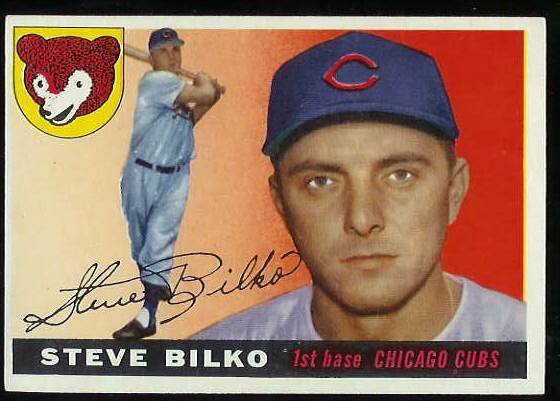
Steve Bilko was an almost mythical minor league slugging star who made such an impression during his short time in Los Angeles that he provided the surname of an iconic 50s sitcom character. The part of the only season he spent in Chicago was unmmemorable but atypical of most of his major league career.
Steven Thomas Bilko was born in Nanticoke, Pa in Nov.1928. Early on his prodigious power attracted many scouts, signing with the Cardinals as a 17 yo in 1945. He gradually climbed the ladder, finally reaching the majors in 1949. However he played only sparingly through 1952. He made a major breakthrough in 1953, hitting 21 HRs and 84 RBIs. However that would be the pattern of his MLB career, showing flashes of greatness but eventually returning to mediocrity, mostly due to his propensity to be a free swinger. The Cubs would buy his contract on April 30, 1954. He would appear in 47 games, hitting 4 HRs and 12 RBIs and .239 BA, although he only struck out 24 times. Following the season he would be let go by the Cubs, but he would sign with the Los Angeles Angels who were actually affiliated with the Cubs at the time. It would be with the Angels where he would come into his own. Over the next 3 seasons Bilko would hit 148 HRs, 426 RBIs. The city of LA would take Bilko into its heart and TV producer Nat Hiken was so impressed by Steve that he would take his last name for the title character of his new sitcom, about a scheming Army Sgt. Althought I think Hiken also liked the sound of Bilk-o, but it will always be linked with the burly 1st baseman. Bilko would continue to get opportunities in the majors, appearing with the Reds and the Dodgers in 1958 and the Tigers in 1960. Then in 1961 he would be drafted by the new major league franchise in LA the Angels where he put together the best overall season of his ML career, hitting 20 HRS, 59 RBIs, .279 BA and even a .395 OBP. He topped that the next season by hitting for the highest BA of his career, .287. However he chose to retire from baseball. His entire career was affected by an eating disorder which may have influenced his ability to have a better career as well as may have contributed to his early death. He moved back to his native Pennsylvania in order to raise his children where he was raised. He would take a job as a salesman with the Dana Perfume Co. where he would work until his death at the age of 49 in 1978.
Doug Bird
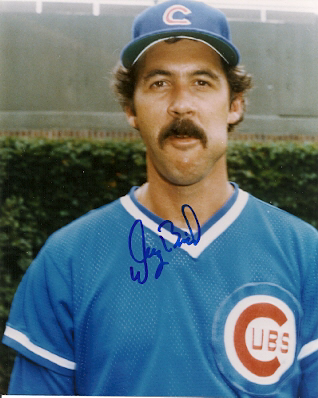
Doug Bird was a journeyman pitcher who had some success as closer in the mid-70s, but with the Cubs he was used as a starter, to mixed results. Born in Corona, Ca. in 1950, Bird would be drafted out of college by the expansion Kansas City Royals in 1969, arriving in 1973 as a relief pitcher, right off the bat saving 20 games as a rookie, earning a 2.99 ERA in 54 games. The next 2 years he would save a total of 21 games, then in 1976 the Royals made the first attempt to turn him into a starter as he would win 12 games. However, the next year it was back in the bullpen, earning 14 saves and 10 wins, but an increasingly rising ERA. In 1978 he was moved out of the closers role and his ERA skyrocketed over 5. He would be traded to the Phillies in 1979, but he continued to struggle. Then in 1980 he would sign with the Yankees and suddenly had a recovery to an ERA of 2.66, the lowest since his 2nd season. In 1981 he got off to a good start but would be traded to the Cubs for Rick Reuschel. Used mostly as a starter, he put up a 4-5 record with a decent 3.58 ERA. However, the next season, which happened to be the first season of the Dallas Green era, he struggled to a 9-14 record and ERA over 5. He also led the league in HRs allowed. It was a disappointing season all around for the Cubs and Birds days in Chicago would be numbered. He would be traded to the Red Sox in return for Chuck Rainey, who actually turned out to be a useful player with the Cubs, while Bird stumbled towards the end of his major league career. Sadly, Ive been unable to find any more information about his post playing career.
- A Dedication/ A Thumbnail History of the Cubs
- News and Notes
- Picture gallery
- Blog
- Marketplace
- more pics
- Ron Santo- A Tribute
- My All Time Cubs All Star Team
- The Al Montreuil Hall of Obscurity
- The Glenn Beckert Hall of Favorites
- Message board
- Books on Cubs
- The Short Unhappy Life of Charlie Hollocher
- Featured Cub of the Week
- Cubbie Memories
- the Cubs A through Z Project
- Adolpho Phillips-The Man Who Would be Willie Mays
- Didnt You Used to be Famous
- Links to other great baseball websites
- Mr Cub-A Tribute